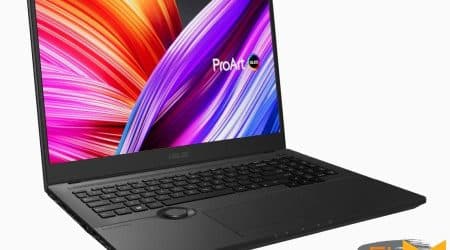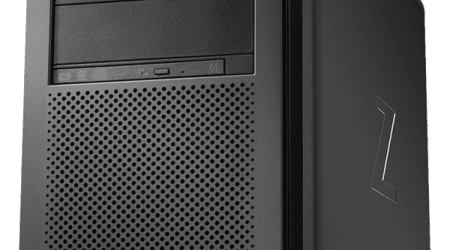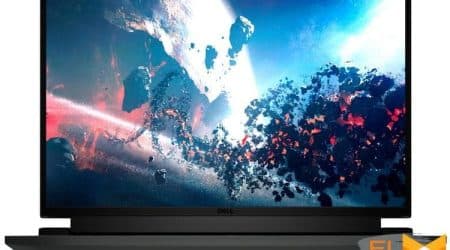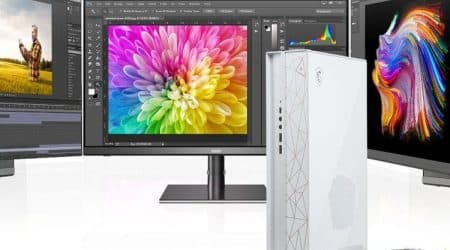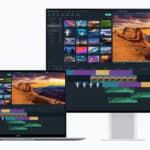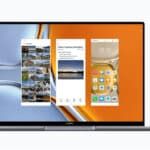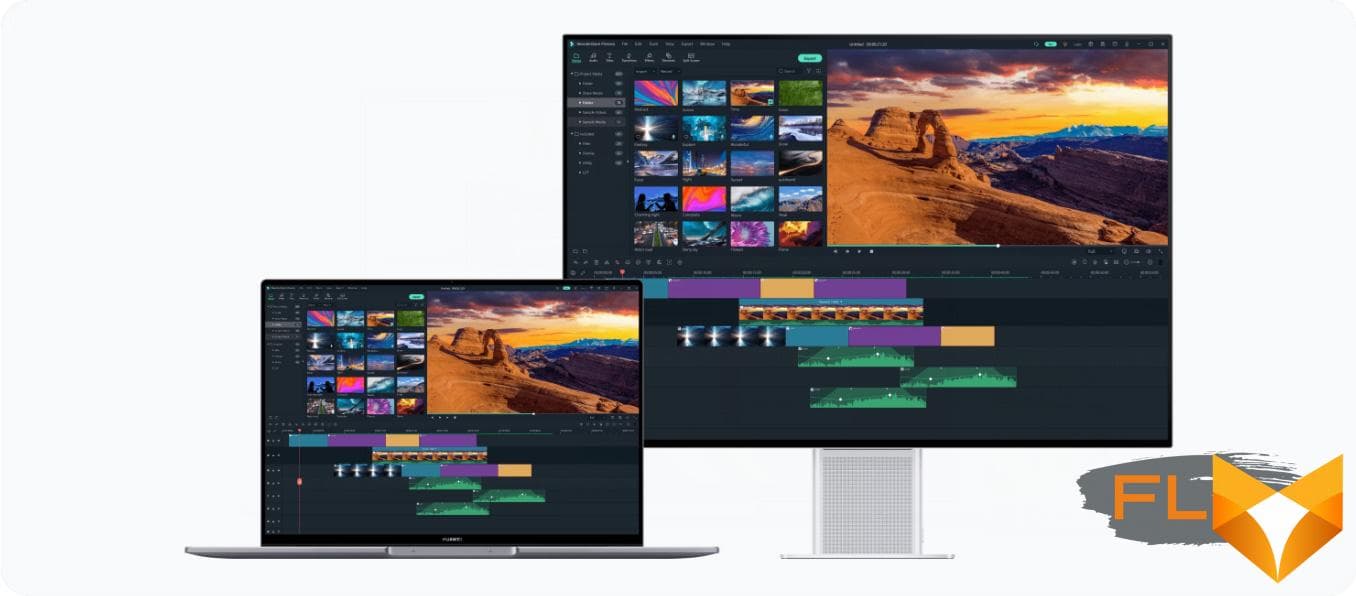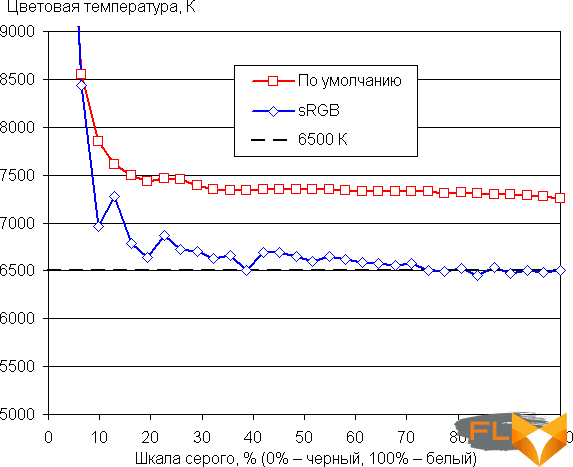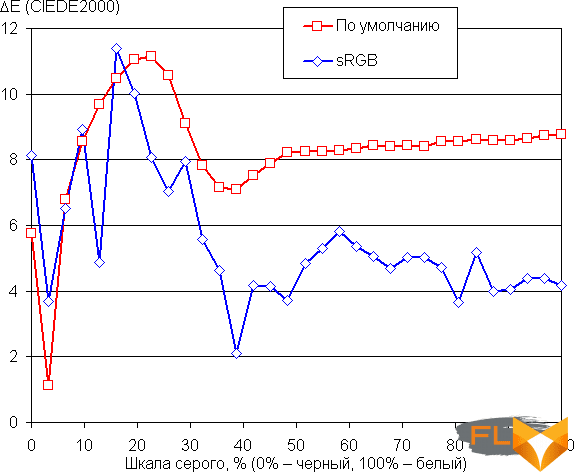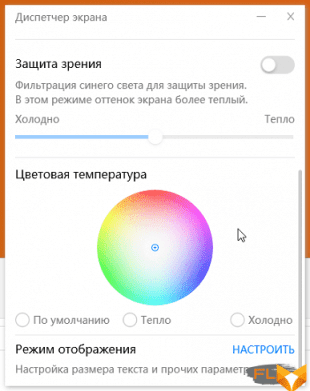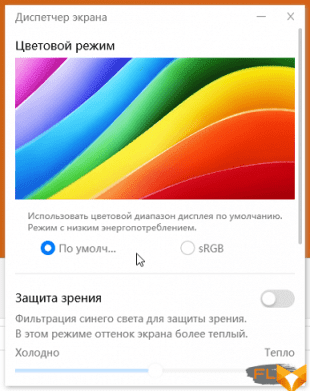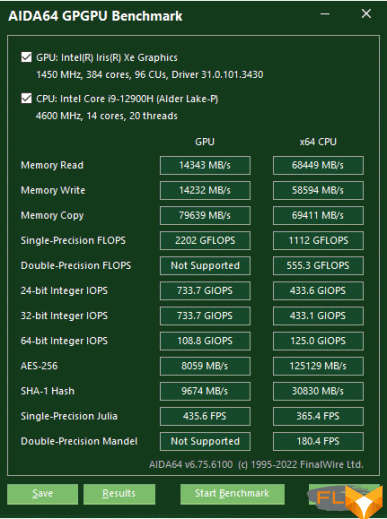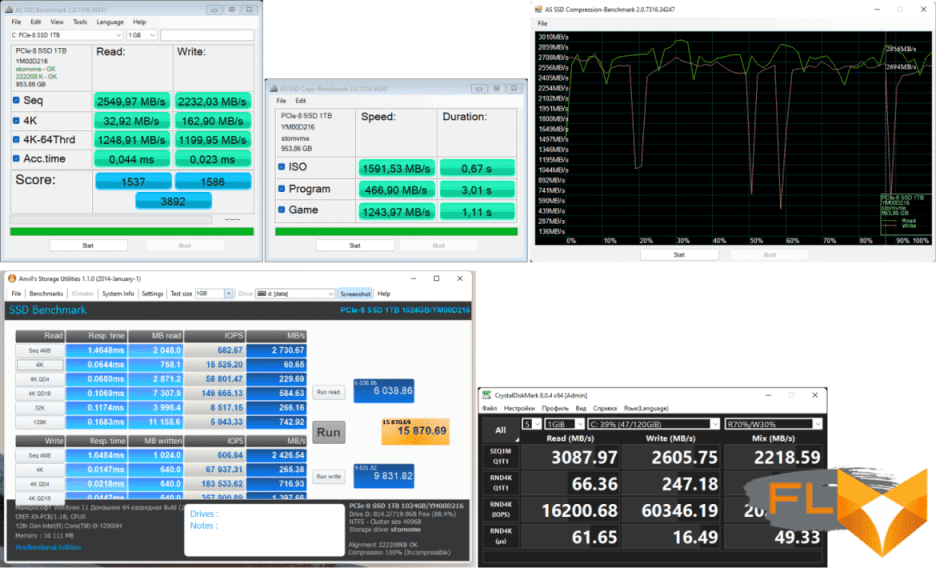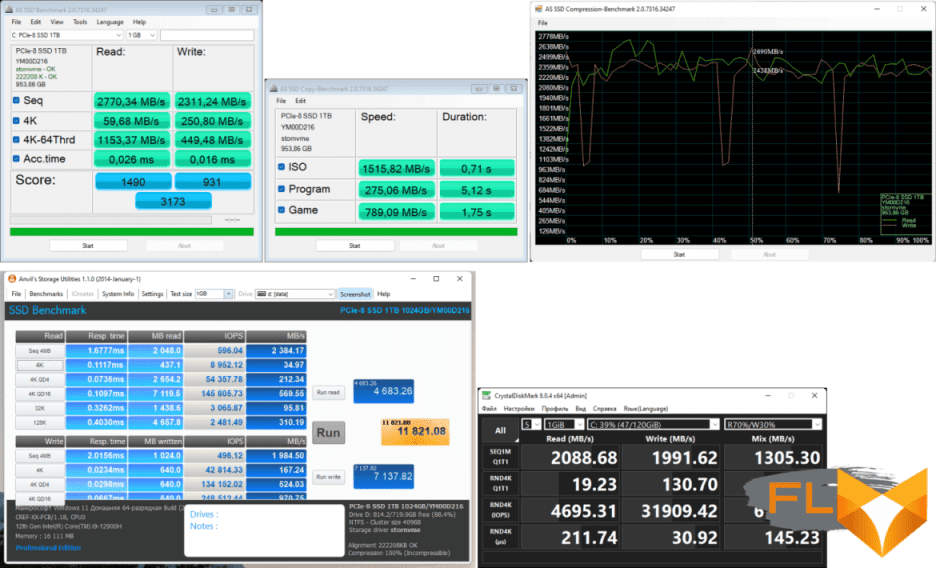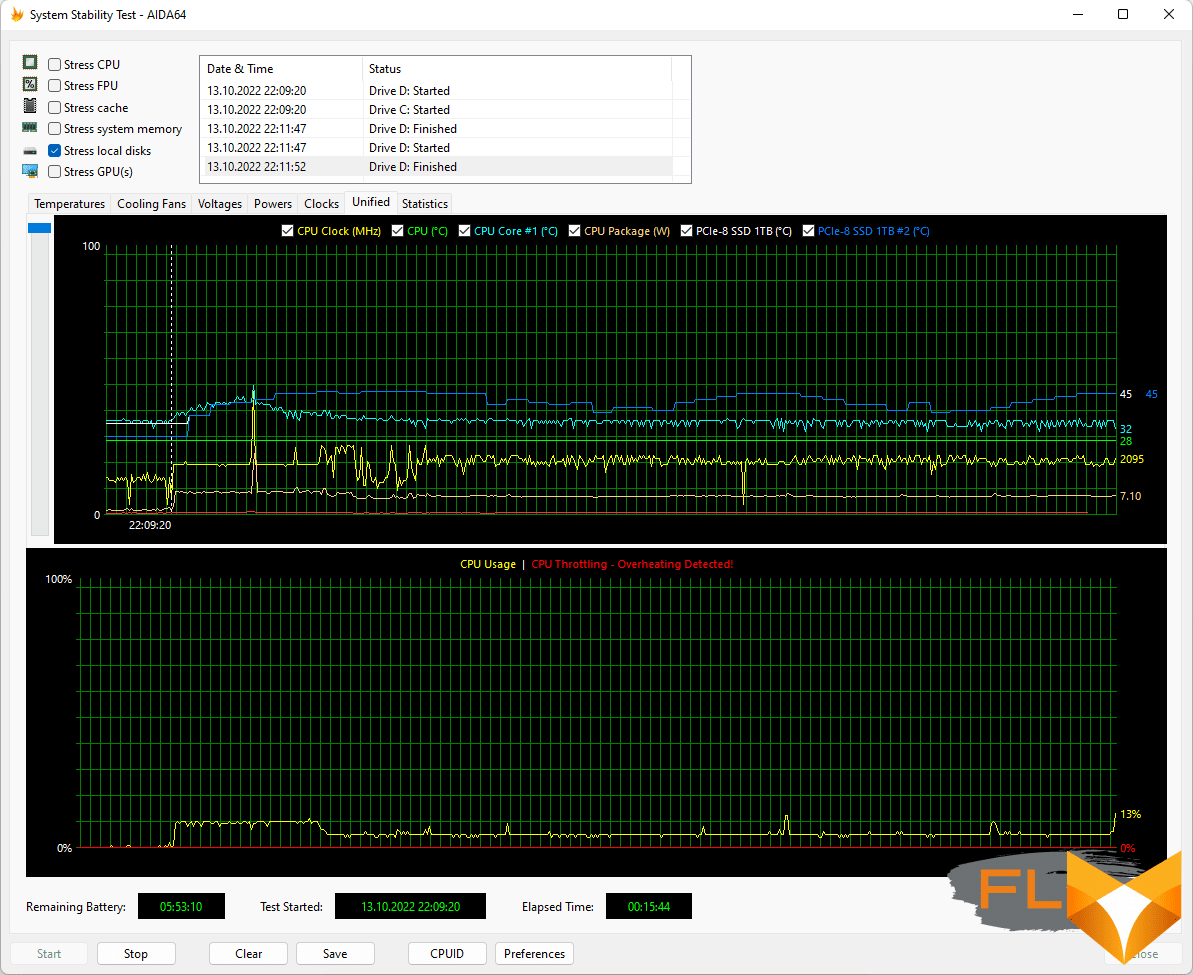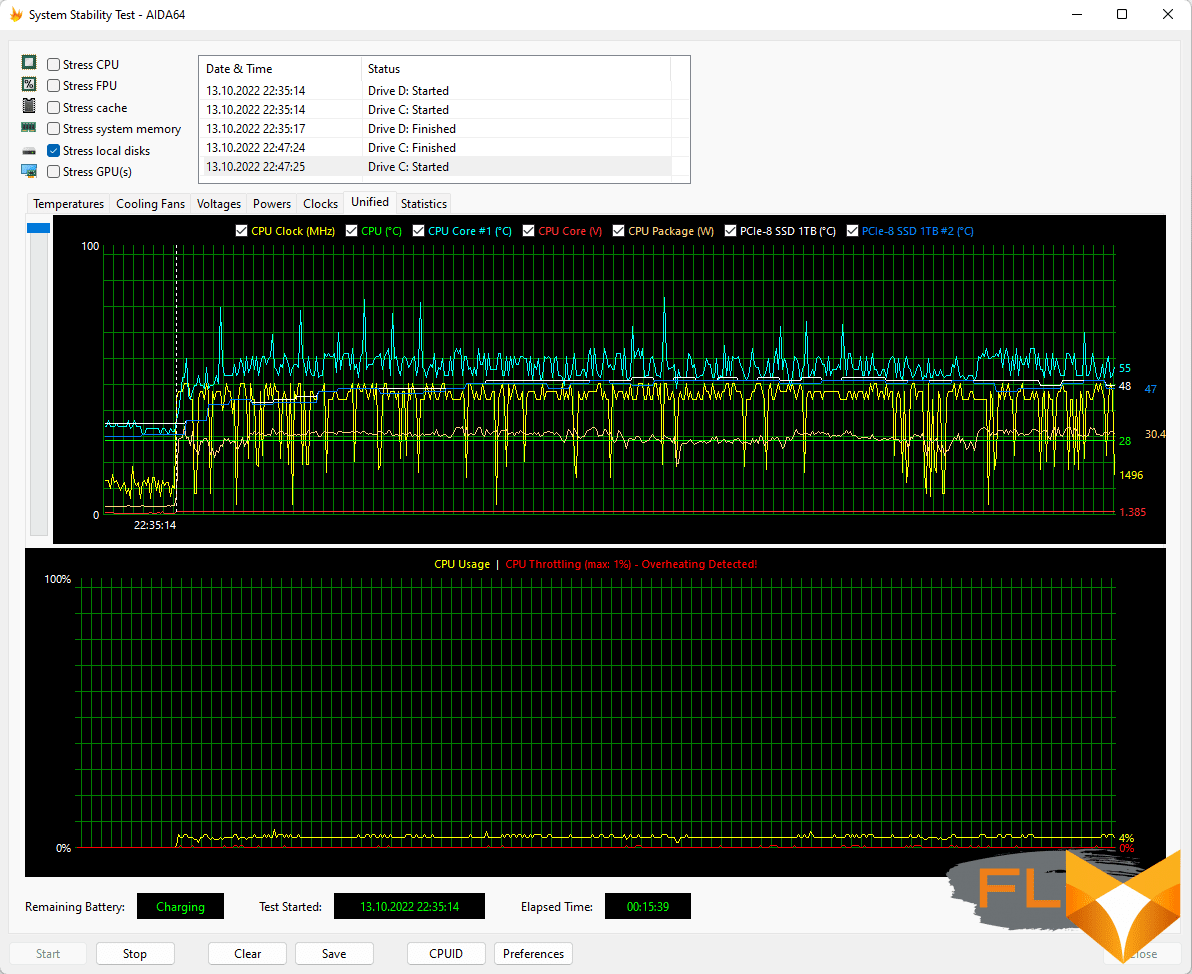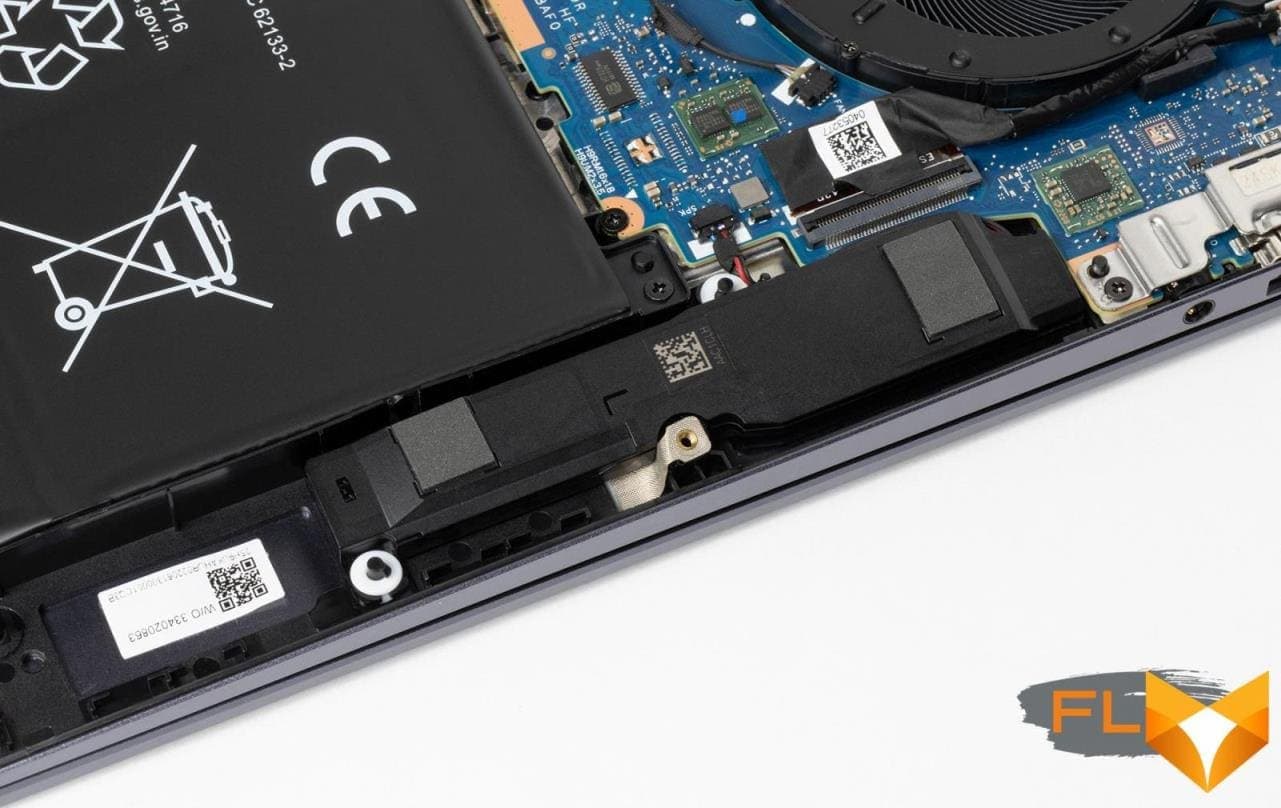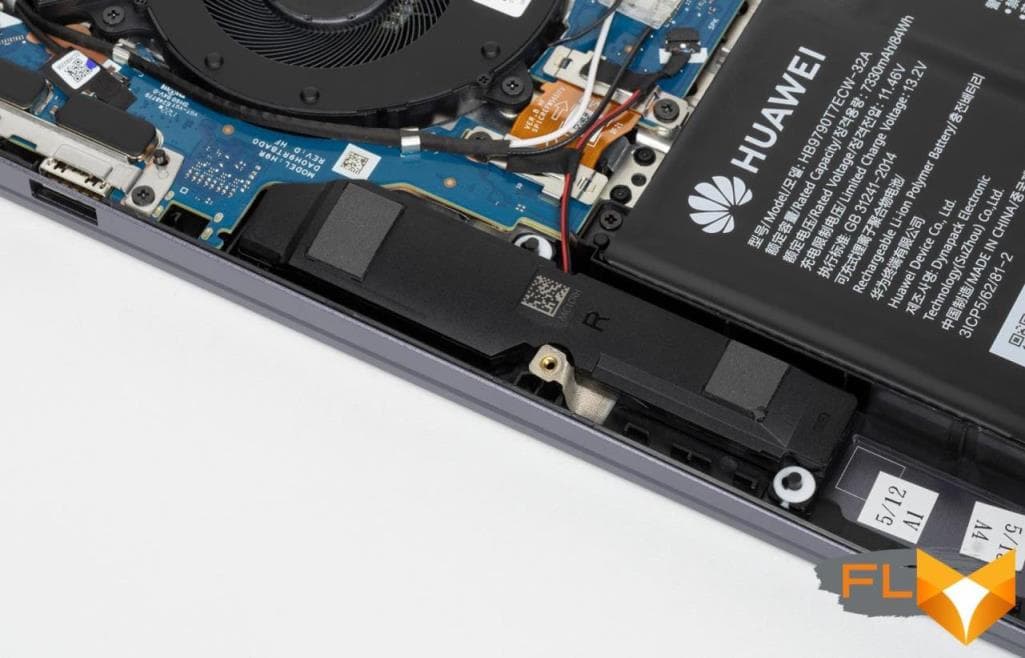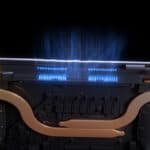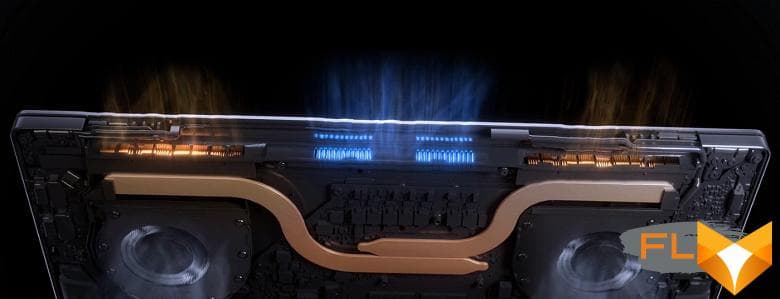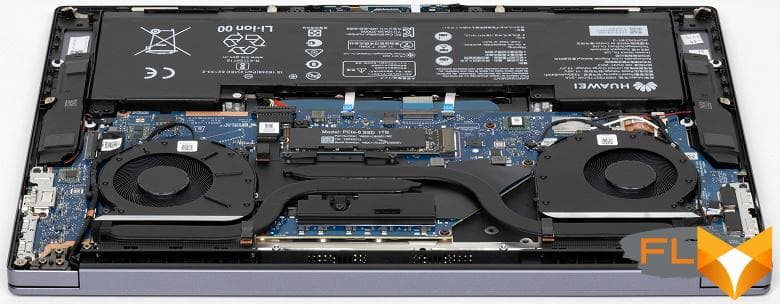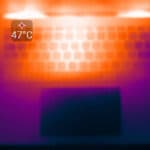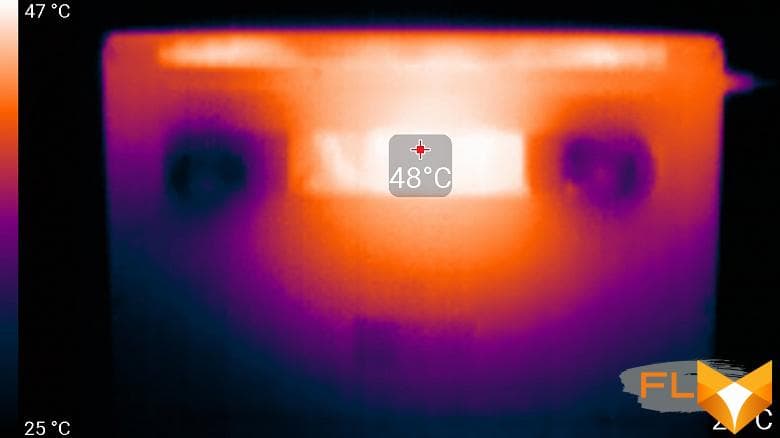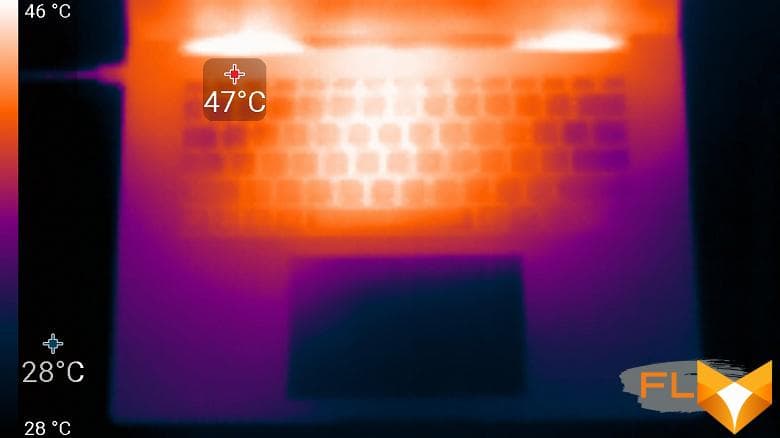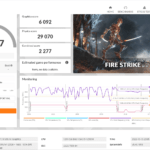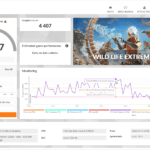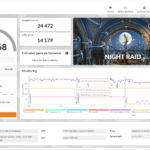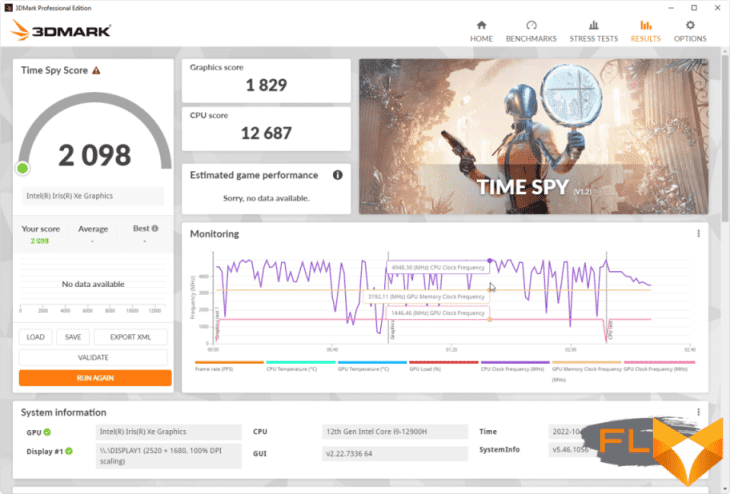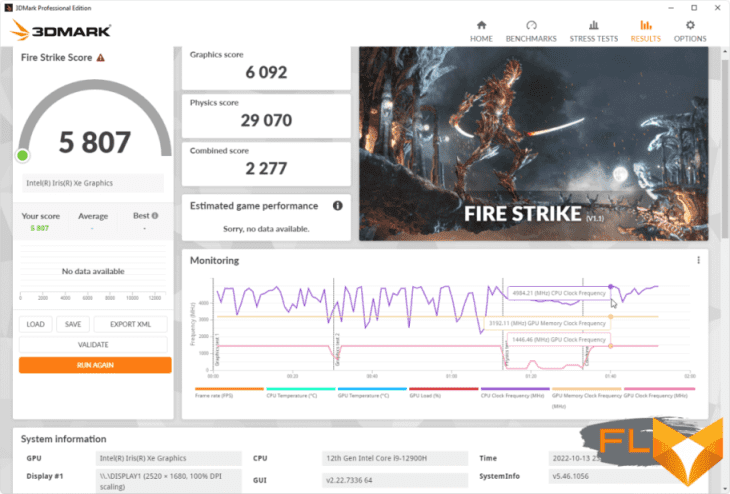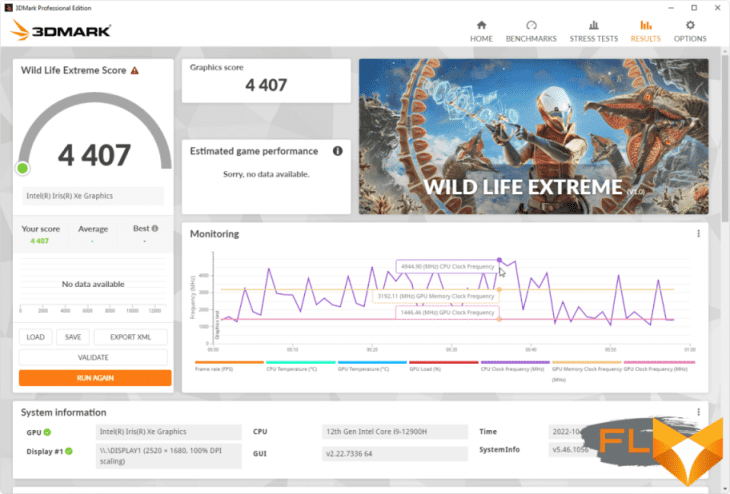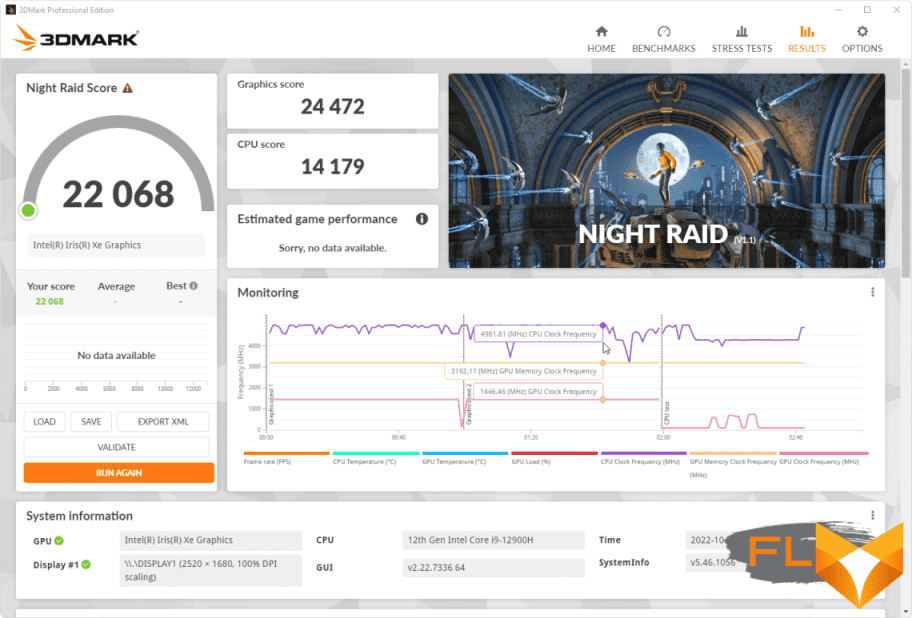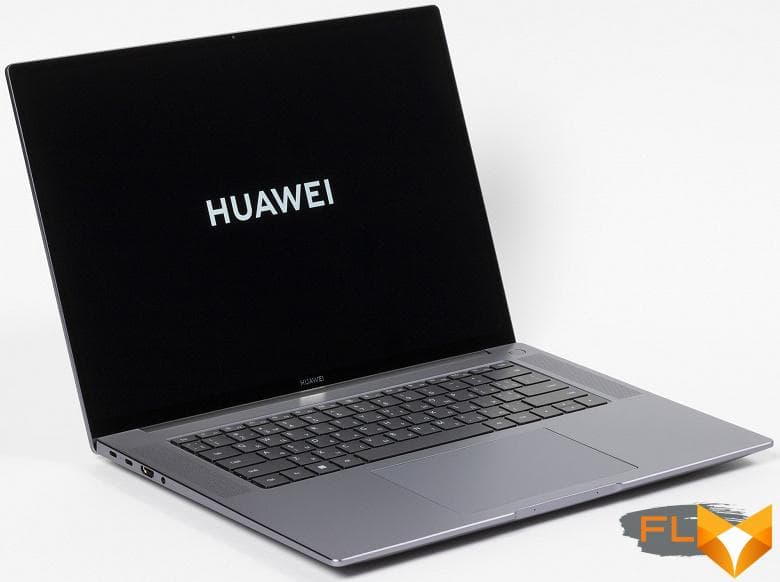


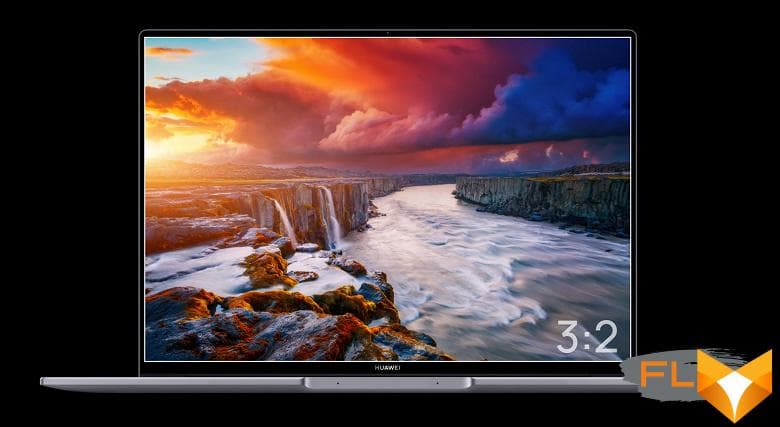
Packages
The package is exactly the same as its predecessor. Among the accessories – only a power supply with a cable and a quick start guide with a “warranty”.
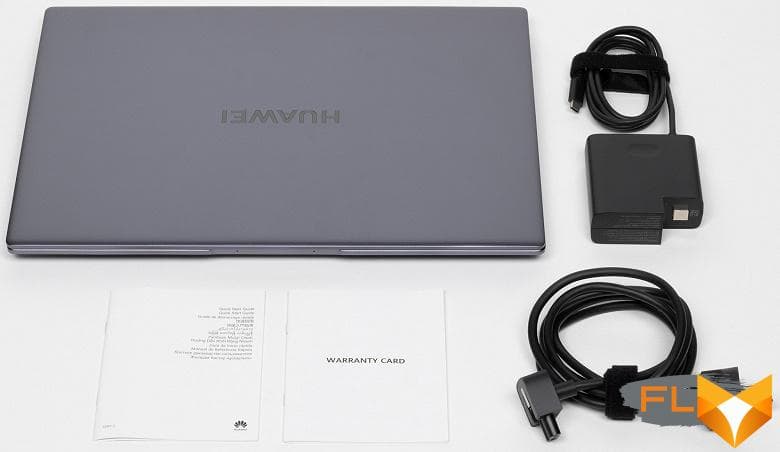
The laptop is manufactured in China and comes with a one-year warranty. In the top configuration, it costs $1,950.
Ultrabook Configuration
| Huawei MateBook 16s (CREF-X) | Processor | Core i9-12900H (6 P-cores/12 threads up to 5.0GHz + 8 E-cores up to 3.8GHz, 24MB L3 cache, TDP 35-115W) ; i7-12700H version available | Chipset | Alder Lake-P PCH | RAM | 16 GB LPDDR5-4800 (soldered on board), dual channel, timings 52-44-44-104 CR1 | Video subsystem | Iris Xe integrated graphics, 1.45 GHz | Screen | 16″ IPS screen with 2520×1680 pixels (3:2), 60Hz, advertised 300 nits, 1500:1 contrast ratio, 100% sRGB color gamut, mirror surface with oleophobic coating, certified by TÜV Rheinland Low Blue Light and TÜV Rheinland Flicker Free | Sound subsystem | 2 stereo speakers | Accumulator | 1xSSD 1TB PCIe-8 (YM00D216), M.2 2280, NVMe, PCIe 3.0 x4 | Card Reader | none | Network interfaces | Wired network | none | Wi-Fi network | Wi-Fi 6E (AX211D2W, 802.11ax, 2×2 MIMO, 2.4/5/6GHz, 160MHz) | Bluetooth | Bluetooth 5.2 | Interfaces and Ports | USB | 1×Thunderbolt 4/USB-C 3.2 Gen2, supports data transfer (max. 40Gbps), charging and DisplayPort; 1×USB-C 3.2 Gen1, support data transfer, charging and DisplayPort; 2×USB-A 3.2 Gen1 | Video outputs | 1×HDMI 1×Thunderbolt 4/DisplayPort (USB-C) 1×DisplayPort (USB-C) | RJ-45 | none | Audio connectors | universal mini-jack for microphone, headphones and headset | Input Devices | Keyboard | membrane without numeric keypad, two-level key illumination (switchable), key travel 1.5 mm | Touchpad | 140x90mm multi-touch support | VoIP | Webcam | 1080p IR built into the top of the screen bezel; functions “Virtual Background”, “Auto Center” and “Change Gaze” | Microphone | 2 microphones (with noise reduction system) | Battery | lithium polymer, 84 Wh (7330 mAh) | Power adapter | HW-200675ED1, up to 135W (20.0V, 6.75A), weight with cables 474g, total cable length 298cm; lower models come with 90W adapter | Dimensions | 352x256x23mm (front thickness 18.5mm) | Weight without power adapter: declared/measured | 1990 / 2016 | Available ultrabook body colors | “Space Gray” | Other features | aluminum housing; built-in Huawei Share (NFC) sensor; productive mode of operation; power button with built-in fingerprint scanner; Huawei PC Manager, Display Manager (Eye Comfort Mode) | Operating system | Windows 11 Home | Official Price | $1950 $1800 for i7-12700H with 1TB SSD | ||||||||||||||||||
|---|---|---|---|---|---|---|---|---|---|---|---|---|---|---|---|---|---|---|---|---|---|---|---|---|---|---|---|---|---|---|---|---|---|---|---|---|---|---|---|---|---|---|---|---|---|---|---|---|---|---|---|---|---|---|---|---|---|---|---|---|---|---|---|---|---|---|---|---|---|---|---|---|---|---|---|---|
Appearance and ergonomics of the case
MateBook 16s is available in only one color – Space Gray, which can already be called branded for Huawei products. It must be remembered that this is not a premium model, but an ordinary “workhorse”, so such a non-staining color suits it perfectly.
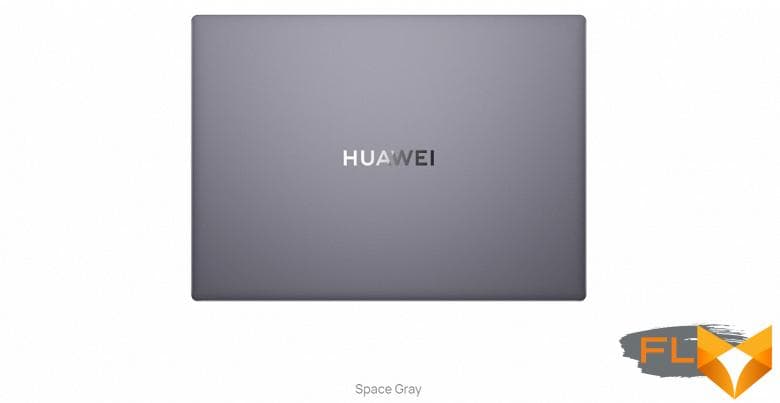
Speaking strictly about the design, in comparison with its predecessor, it has undergone one meager change. You won’t be able to detect it right away, since we are talking about a webcam that has migrated from the function row button to the top of the display frame.
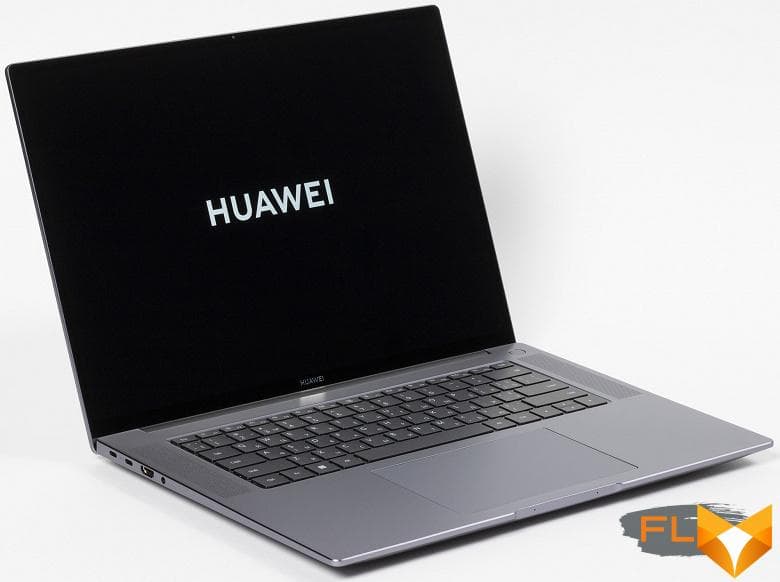
Nothing else has changed at all, but it can hardly be said that the laptop has become worse and less interesting from this. The lid and worktop of the MateBook 16s are still made from sandblasted aluminum.

The dimensions of the device are the same and are 352 × 256 × 23 mm, and the weight of the laptop is about two kilograms, which is somewhat large for a non-gaming even 16-inch model, but here there is a metal case and a reinforced cooler.
In addition to dense rubber legs on the plastic base of the ultrabook, we will single out a relatively large ventilation grill for air to flow to the cooling system fans.
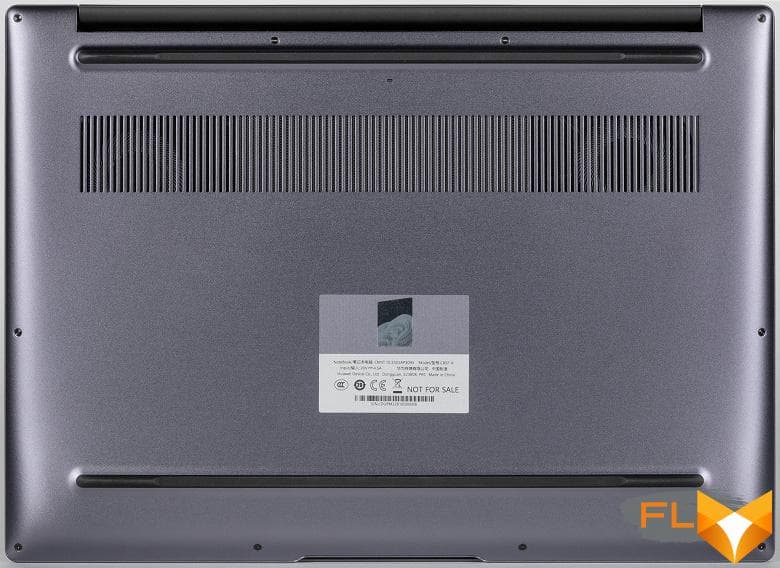
Towards the front end, the laptop body narrows, so it seems that it is thinner than it actually is. There is also a notch for easy finger grip of the top panel and two microphones.


The number and design type of laptop ports have not changed: on the left are two USB 3.2 Type-C, HDMI video output and a universal 3.5 mm headphone/microphone jack, and on the right are two USB 3.2 Gen1 Type-A.


However, one of the two USB Type-C on the MateBook 16s is a Thunderbolt 4 interface port with a bandwidth of up to 40 Gb / s, support for reverse charging and video output (DisplayPort).
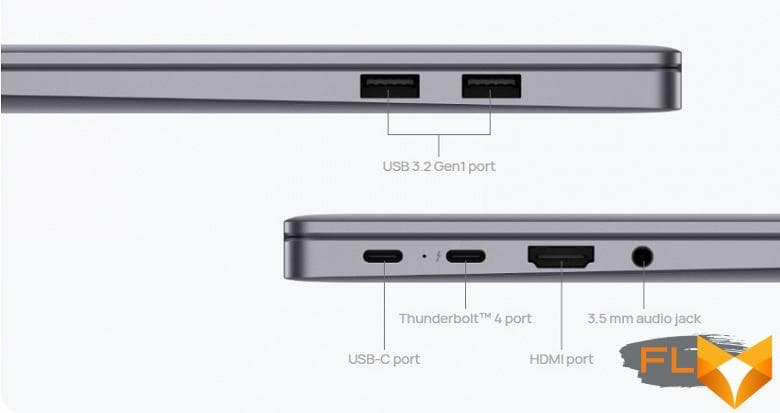
A set of interfaces that is quite exhaustive in terms of demand, as it seems to us. However, with such a thickness of the case, an RJ-45 cable network connector could be added.
The lid of the laptop can be easily opened with one hand without holding the base, and the opening angle is 150 degrees.

Although Huawei does not position the MateBook 16s as a premium model, the build quality of the laptop is impeccable, and the materials used are both tactile and visually pleasing.
Input Devices
The keyboard in Huawei MateBook 16s did not change at all, it does not have a numeric block and a column with Page Up and Page Down keys, but the alphanumeric keys are large enough to type comfortably.
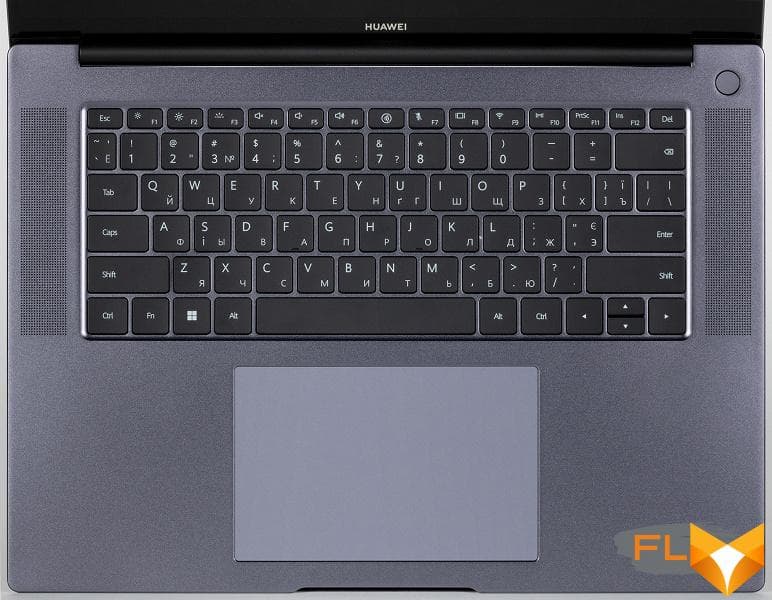
The key travel is 1.5 mm. Pressing is soft and quiet, but the moment of operation is felt well, so the number of errors when typing is minimal.
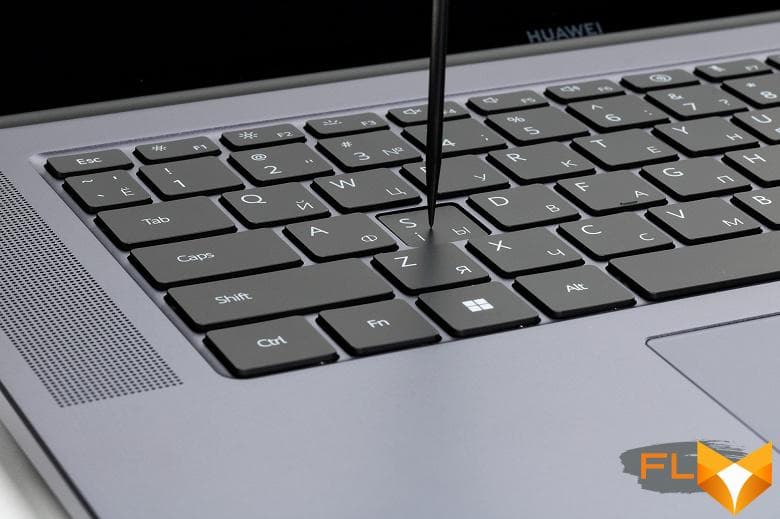
Both layouts are printed in a well-readable white font in opposite corners of the keys.
The keyboard still has a two-level backlight, but even at the maximum level and in complete darkness, it can hardly be called bright.

The touchpad is comfortable with its dimensions – 140×90 mm, as well as a smooth surface with a glass coating and optimal sensitivity.

The webcam has now been moved into the frame of the screen and put on a higher quality sensor with a resolution of 1080p, an 88-degree field of view and an intelligent tracking system, support for virtual background and eye contact functions.
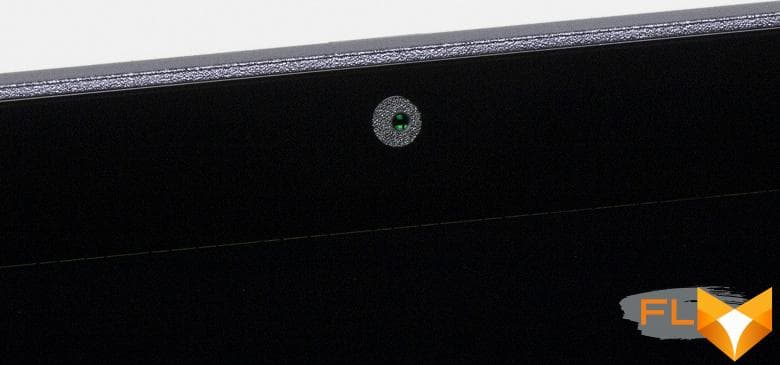
The fingerprint scanner is built into the button located in the far right corner of the operating panel.
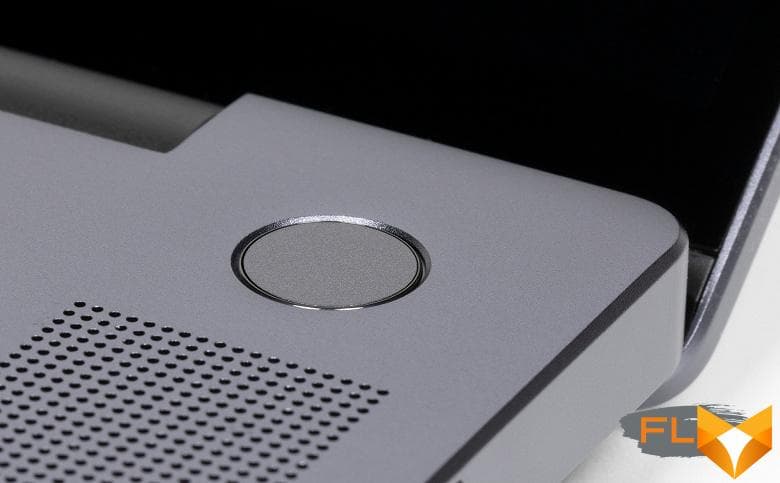
Huawei Share proprietary technology has now been supplemented with the “Superdevice” function, thanks to which you can literally pair your laptop with smartphones, tablets, monitors, smart screens and other Huawei devices with just a couple of clicks.

Thus, you can not only manage files on a smartphone or tablet, but also edit them and then save them to the memory of mobile devices. You can also easily answer voice or video calls.
Screen
Glass covers the entire surface of the laptop screen, so marketers have every reason to call it frameless. However, the width of the side bezels here is 6mm and the bezel top is 8mm. The Huawei MateBook 16s (CREF-X) uses a 16.0-inch IPS panel with a resolution of 2520×1680.

The front surface of the screen is made of scratch-resistant glass plate. The screen is mirror-smooth on the outside. There is a special oleophobic (grease-repellent) coating on the outer surface of the screen, which is noticeably better in efficiency than the screen of the Google Nexus 7 (2013) tablet (hereinafter simply Nexus 7), so fingerprints are removed much easier and appear at a slower rate than in the case of ordinary glass. The screen is touch, the sensor recognizes up to 10 touches at the same time. Judging by the brightness of the reflected objects, the anti-glare properties of the screen are no worse than those of the Nexus 7. For clarity, here is a photo in which a white surface is reflected on the screens of both devices (it’s easy to figure out where what):
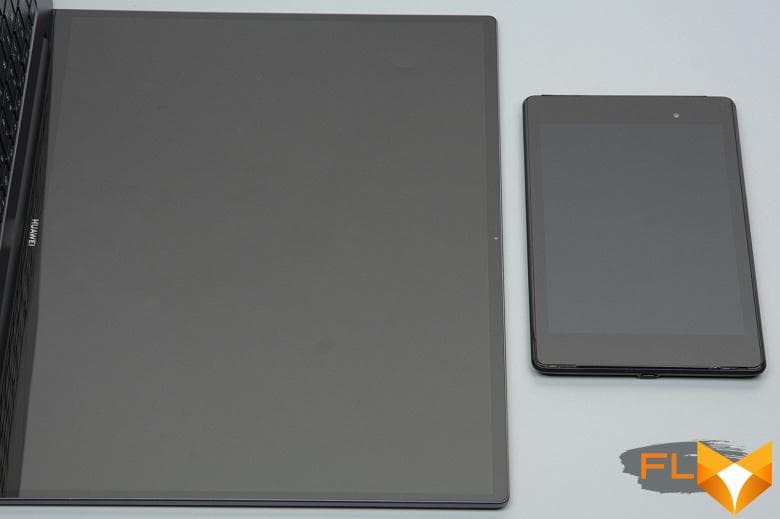
The screen of the laptop is just as dark (the brightness is 99 for both photos), which means that the screen does not have a special anti-glare coating. We did not find any significant doubling of the objects reflected in the screen, that is, there is no air gap in the layers of the screen.
When powered from the mains or from the battery and with manual brightness control (there is no automatic adjustment by the light sensor), its maximum value was 330 cd / m² (in the center of the screen on a white background). If you avoid direct sunlight, then this value allows you to somehow use the laptop on the street, even on a sunny summer day.
To evaluate the readability of the screen outdoors, we use the following criteria obtained from testing screens in real conditions:
| Maximum brightness, cd/m² | Conditions | Readability Score |
|---|---|---|
| Matte, semi-matte and glossy screens without anti-glare | ||
| 150 | Direct sunlight (over 20,000 lux) | illegible |
| Light shadow (about 10000 lux) | barely readable | |
| Slight shade and light clouds (no more than 7500 lux) | uncomfortable to work | |
| 300 | Direct sunlight (over 20,000 lux) | barely readable |
| Light shadow (about 10000 lux) | uncomfortable to work | |
| Slight shade and light clouds (no more than 7500 lux) | work comfortably | |
| 450 | Direct sunlight (over 20,000 lux) | uncomfortable to work |
| Light shadow (about 10000 lux) | work comfortably | |
| Slight shade and light clouds (no more than 7500 lux) | work comfortably | |
These criteria are very conditional and may be revised as data accumulate. Note that there may be some improvement in readability if the matrix has some kind of transreflective properties (part of the light is reflected from the substrate, and the image can be seen in the light even with the backlight turned off). Also, glossy matrices, even in direct sunlight, can sometimes be rotated so that they reflect something quite dark and uniform (on a clear day, for example, the sky), which will improve readability, while matte matrices need to be blocked from Sveta. In rooms with bright artificial light (about 500 lux), you can work more or less comfortably even with a maximum screen brightness of 50 cd / m² and below, that is, in these conditions, maximum brightness is not an important value.
Let’s return to the screen of the tested laptop. If the brightness setting is 0%, then the brightness is reduced to 5 cd/m². Thus, in complete darkness, the screen brightness can be lowered to a comfortable level.
At any brightness level, there is no significant backlight modulation, so there is no screen flicker. As proof, here are graphs of the dependence of brightness (vertical axis) on time (horizontal axis) at various values of the brightness setting:

This laptop uses an IPS type matrix. Micrographs show a typical IPS subpixel structure (black dots are dust on the camera’s matrix):
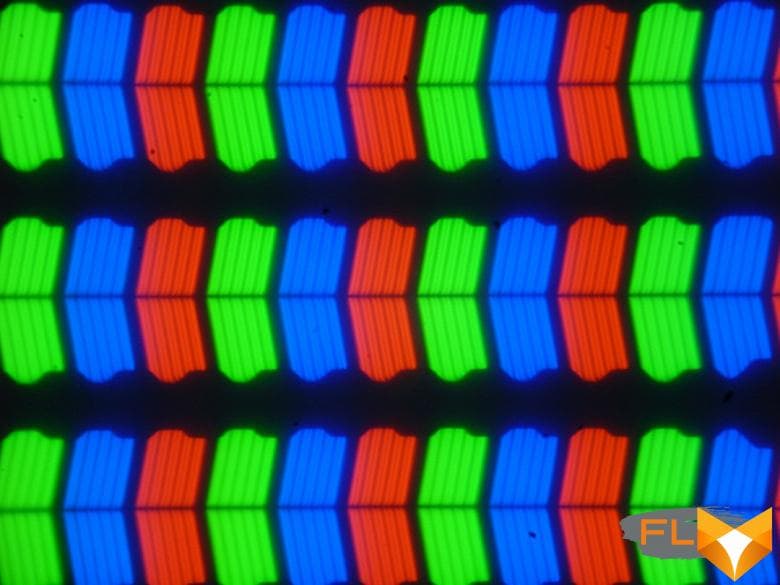
There is no “crystal” effect for obvious reasons.
We measured brightness at 25 screen points spaced in 1/6th increments of the screen width and height (screen borders not included). The contrast was calculated as the ratio of the brightness of the fields at the measured points:
| Parameter | Average | Mean Deviation | |
|---|---|---|---|
| min., % | max % | ||
| Black box brightness | 0.24 cd/m² | −9.5 | 9,2 |
| White box brightness | 330 cd/m² | −6,1 | 4,4 |
| Contrast | 1400:1 | −9,6 | 4,4 |
If you step back from the edges, then the uniformity of all three parameters is very good. Contrast by modern standards for this type of matrices is higher than typical. The photo below gives an idea of the distribution of the brightness of the black field over the screen area:

It can be seen that the black field closer to the edge is still highlighted in places. However, the uneven illumination of black is visible only on very dark scenes and in almost complete darkness, it should not be considered a significant drawback.
The screen has good viewing angles without significant color shift even at large deviations of the gaze from the perpendicular to the screen and without inverting shades. However, the black field, when deviated diagonally, is strongly highlighted and acquires a slight purple hue.
Response time for black-white-black transition is 20ms (10ms on + 10ms off), transition between grayscale total (from hue to hue and back) takes an average of 32ms . The matrix is not fast, there is no overclocking.
We determined the total output delay from switching pages of the video buffer to the start of displaying the image on the screen (recall that it depends on the features of the Windows OS and the video card, and not only on the display). At a refresh rate of 60 Hz (and no other value is available), the delay is 35 ms. This is not a very large delay, it is not felt when working on a PC, but in fast-paced games it can still lead to a decrease in performance.
Next, we measured the brightness of 256 shades of gray (from 0, 0, 0 to 255, 255, 255). The graph below shows the increase (not an absolute value!) in brightness between adjacent halftones:
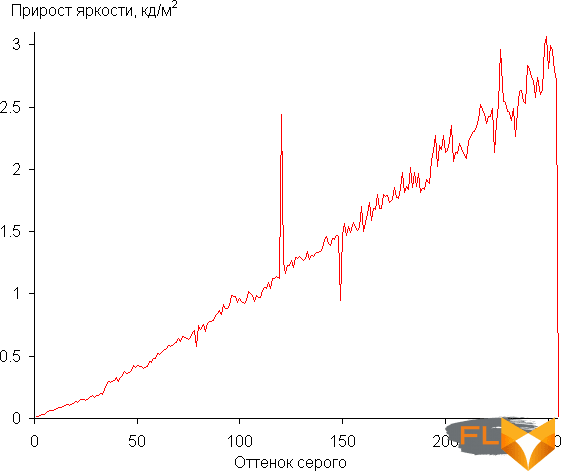
Growth gain on the gray scale is mostly uniform, and each successive shade is brighter than the previous one, with the exception of one of the lightest shades of gray, which does not differ in brightness from white. However, this does not spoil the overall picture. In the darkest area, all shades are hardware and visually different:
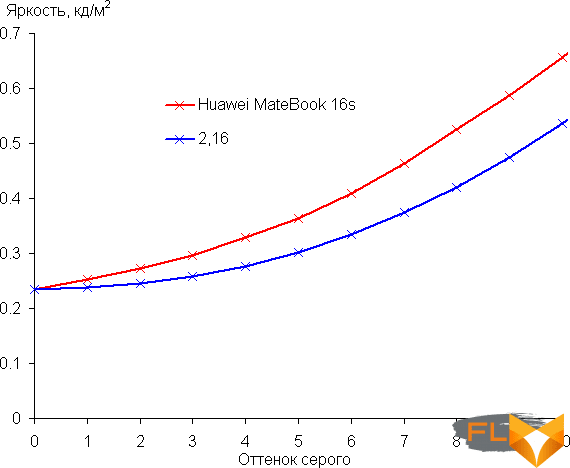
Approximation of the resulting gamma curve gave an indicator of 2.16, which is slightly lower than the standard value of 2.2, while the real gamma curve deviates little from the approximating power function:
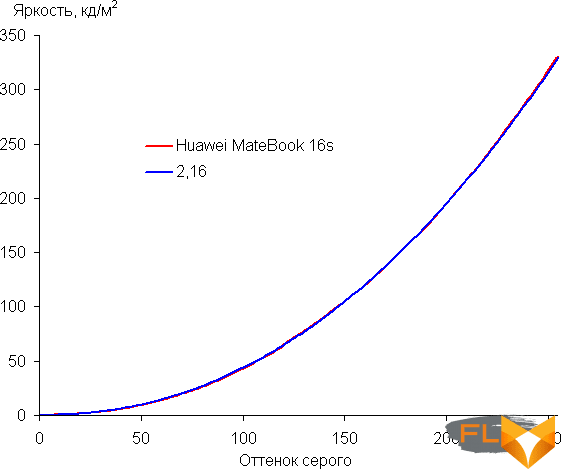
The color gamut is very close to sRGB:
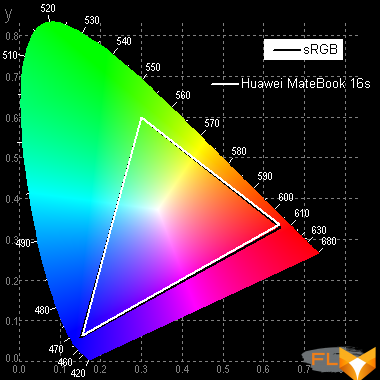
Therefore, the colors of normal images optimized for display on devices with sRGB coverage are naturally saturated. Below is the spectrum for a white field (white line) superimposed on the spectra of red, green and blue fields (lines of the corresponding colors):
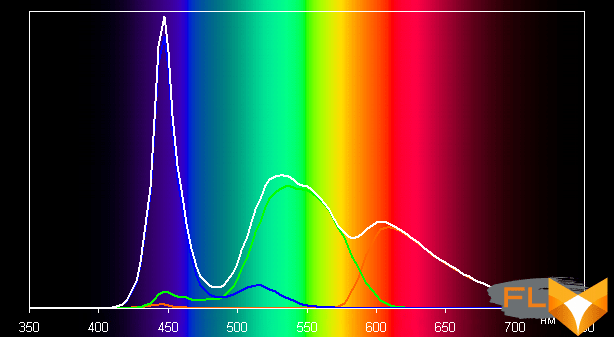
Such a spectrum with a relatively narrow peak of blue and with wide humps of green and red colors is typical for screens that use a white LED backlight with a blue emitter and a yellow phosphor.
By default, the balance of shades on the gray scale is acceptable, since the color temperature is quite close to the standard 6500 K, and the deviation from the black body spectrum (ΔE) is only in the dark area slightly above 10, which can be forgiven for a consumer device. At the same time, the color temperature and ΔE change little from shade to shade – this has a positive effect on the visual assessment of color balance. (The darkest areas of the gray scale can be ignored, since the color balance does not matter much there, and the measurement error of color characteristics at low brightness is large.)
If you turn on the sRGB profile in the screen settings, then the color gamut practically does not change, but the color temperature becomes closer to 6500 K and ΔE in the bright area decreases (the graphs above are labeled sRGB). But the ΔE spread increases, while the maximum brightness and contrast decrease. There is no particular point in including this profile. Also, in theory, the color balance can be corrected by moving a point on the color wheel or by selecting preset correction profiles, but any intervention (turning on the Eye protection option too) leads to an abnormal change in the gamma curve, only it helps to return it to normal removing the graphics driver and installing it back.
Let’s summarize. The screen of this laptop has a high enough maximum brightness (330 cd/m²) to allow the device to be used outdoors on a bright day, shielded from direct sunlight. In complete darkness, the brightness can be reduced to a comfortable level (up to 5 cd / m²). The advantages of the screen include high contrast (1400:1), acceptable color balance and sRGB color gamut. The disadvantages are the low stability of black to the deviation of the gaze from the perpendicular to the plane of the screen. In general, the screen quality is high.
Disassembly options and components
By and large, up to this point in Huawei MateBook 16s there were no major changes compared to its predecessor. But this and the following sections will fully convince you that the release of version 16s was worth it, since inside the laptop case there is now a hardware platform with an Alder Lake processor family.
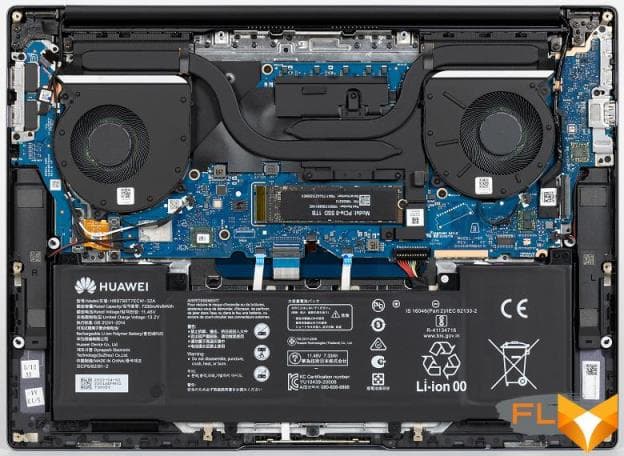
The laptop motherboard with the laconic name CREF-XX-PCB is based on the Alder Lake-P PCH chipset. Her BIOS version is 1.18. No automatic updates were found.
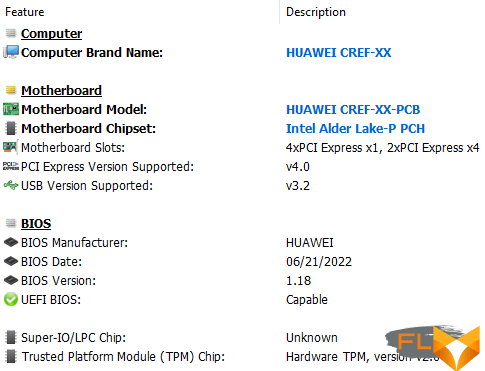
Our version of Huawei MateBook 16s is equipped with a Coge i9-12900H processor, which has 6 productive cores (12 threads) with automatic overclocking to 5 GHz, as well as 8 energy-efficient cores with overclocking up to 3.8 GHz.

The amount of L3 cache in the processor is 24 MB. Processor power limits range from 35 to 115 watts, although HWinfo64 shows the processor has an upper limit of 116.25 watts.
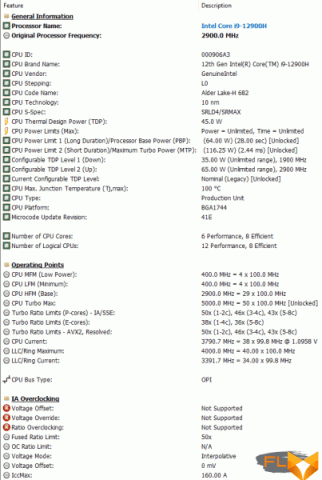
The temperature at which the throttling mode will be activated is 100 °C, but in practice this limit is slightly lower. Recall that you can also purchase Huawei MateBook 16s with a Coge i7-12700H processor.
As RAM, Huawei MateBook 16s uses 16 GB LPDDR5 with an effective frequency of 4.8 GHz and basic timings of 52-44-44-104 CR1.

The chips are soldered to the motherboard, so there is no way to increase the volume, and there are no options for the MateBook 16s with 32 or 64 GB of memory yet. The memory bandwidth is atypically high for laptops, but the latency leaves much to be desired.
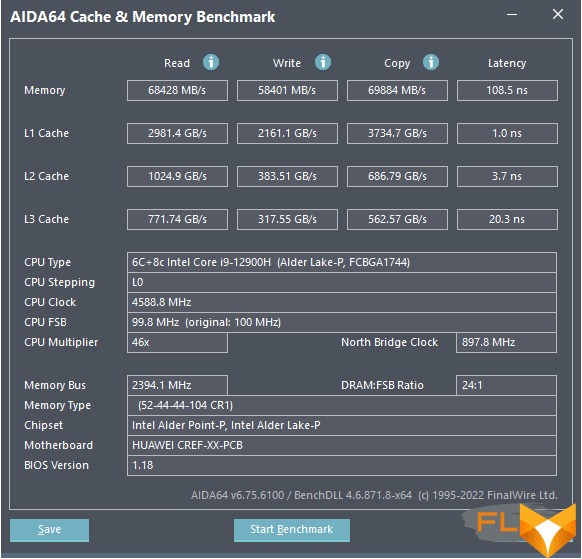
However, this is not a gaming laptop, so there is nothing critical in such high latency.
There is no discrete graphics in the laptop, so the only possible option is the Iris Xe core built into the central processor with 96 execution units and a frequency in 3D mode up to 1.45 GHz. Its characteristics and test results are given below.
The Huawei MateBook 16s has only one M.2 storage slot, which has a 1TB PCIe-8 SSD without a heat spreader.
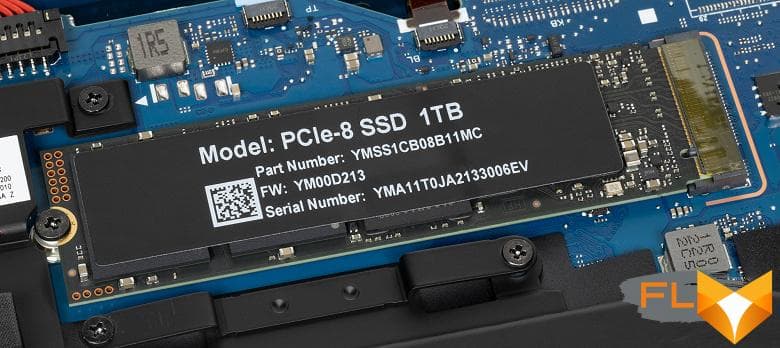
The Coge i7-12700H version of the MateBook 16s also comes with a 1TB SSD.
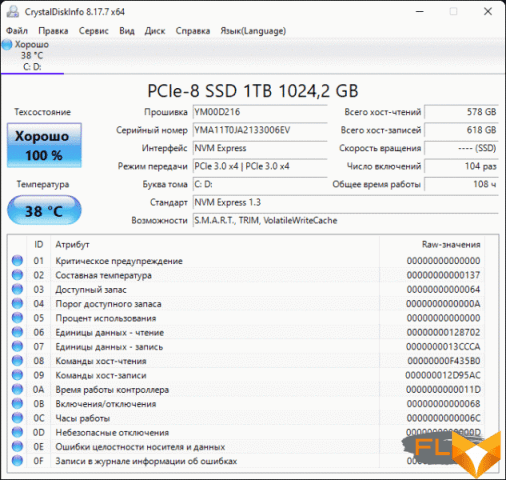
SSD performance is average by today’s standards, but more than adequate for the tasks the MateBook 16s is capable of handling. We will show the test results in two screenshots:
As you can see, in the offline mode of the laptop, the performance of the SSD is lower than when working from the mains. The difference is about 25%-30%. Compared to the performance of a regular MateBook 16 drive, there is almost no difference.
SSD temperatures also differ depending on the mode of operation of the laptop. We will demonstrate this difference with the stress test results of an AIDA64 drive.
In the first case, the SSD heated up to 50-52 °C, and in the second case, up to 45 degrees. In other words, there is nothing to worry about, regardless of whether the laptop is running offline or on mains power.
Unlike the MateBook 16, which is equipped with a Realtek RTL8822CE network controller, the 2022 model received a more modern Wi-Fi network controller 6E AX211D2W with Bluetooth 5.2 support and a throughput of up to 2.4 Gbps.
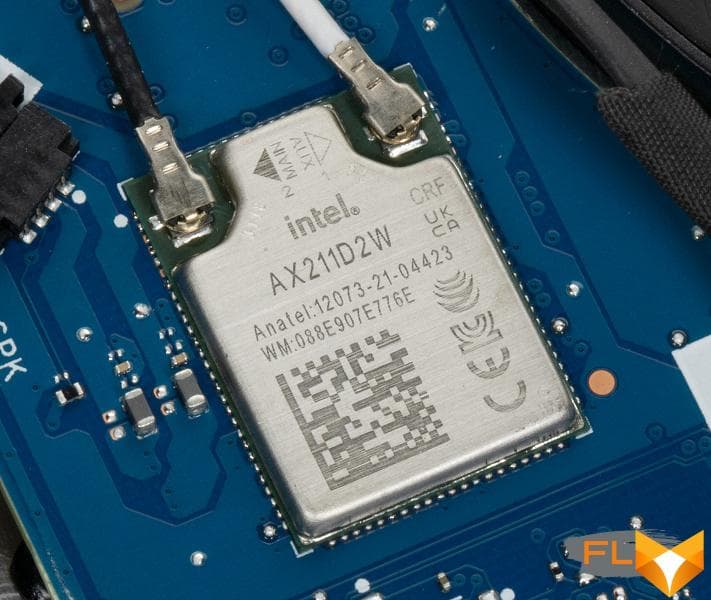
Supported frequencies are 2.4, 5 and 6 GHz, as well as 2×2 MIMO mode and security protocols up to and including WPA3. By the way, the network controller is soldered on the board and it will not work to change it.
The sound system is still implemented by two stereo speakers built into the sides of the keyboard.
Supports proprietary sound enhancement systems Smart Optimization, Ultra-Bass and Sound Turbo.
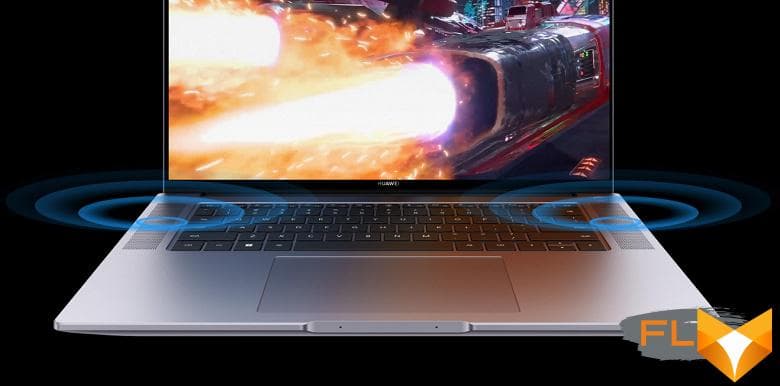
The loudness of the built-in loudspeakers was measured while playing an audio file with pink noise. The maximum volume was 78.6 dBA, so among the laptops tested at the time of this writing (maximum 83 dBA, median 74.6 dBA), this laptop is noticeably louder than average in volume.
| Model | Loudness, dBA | MSI P65 Creator 9SF | 83.0 | Apple MacBook Pro 13″ (A2251) | 79.3 | Huawei MateBook 16s (2022) | 78.6 | Asus ROG Zephyrus S17 | 77.5 | HP Omen 15-ek0039ur | 77.3 | Dell Latitude 9510 | 77.0 | Apple MacBook Air (Early 2020) | 76.8 | MSI Modern 15 A5M | 76.3 | MSI Stealth 15M A11SDK | 76.0 | MSI GP66 Leopard 10UG | 75.5 | Apple MacBook Pro 13″ (Apple M1) | 75.4 | Asus TUF Gaming F15 (2022) | 75.2 | Gigabyte Aero 15 OLED XC | 74.6 | Realme Book RMNB 1002 | 74.4 | Infinix Inbook X2 XL21 | 74.3 | MSI Katana GF66 11UG | 73.9 | Honor MagicBook Pro | 72.9 | Machenike S17 | 72.4 | LG gram 17Z90P | 72.1 | Lenovo Yoga Slim 7 Pro 14ACH5 | 72.0 | Thunderobot 911 Air D | 71.2 | Asus ROG Flow Z13 (2022) GZ301Z | 68.8 | Asus ZenBook 14 (UX435E) | 64.8 |
|---|
The frequency response of pink noise shows that low frequencies are expectedly small, and this dependence cannot be called even:

Cooling system and load operation
Since the Huawei MateBook 16s now has a more powerful hardware platform, the developers needed to improve the efficiency of the cooling system. This was done by replacing two through 6mm heat pipes with two individual 8mm ones.
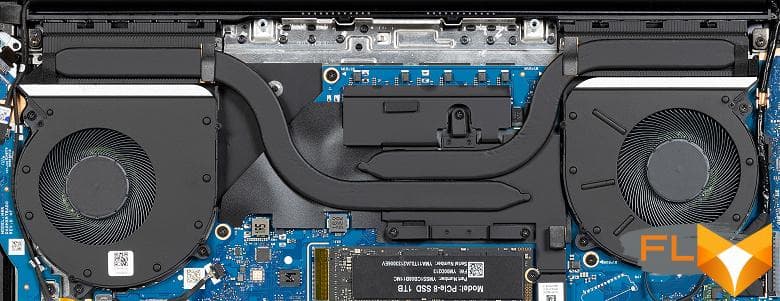
It also looks like the fan impellers with Shark Fin blades have been enlarged. But fundamentally, the operation of the cooling system has not changed: cold air is sucked in from below and in the center of the rear end, and the heated air is thrown back through the copper fins of the radiators.
As before, Huawei PC Manager provides two laptop modes: Performance and Balance, which can be switched with the Fn + P key combination. It is not very convenient that every time you boot your laptop you have to activate the performance mode, since the balanced one is set by default.
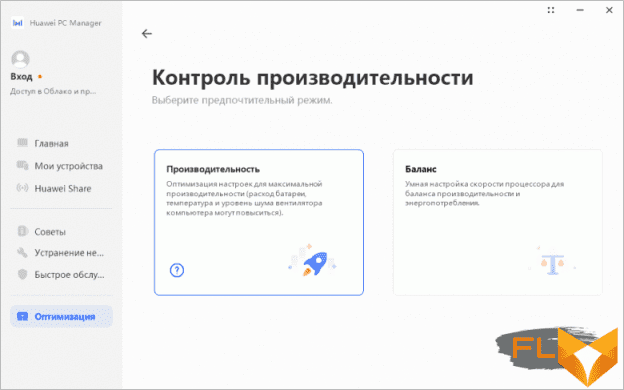
We tested both modes of the Huawei MateBook 16s on mains power using the powerMax stress test with AVX instructions for the processor, and monitoring was carried out using the customized HWinfo64 utility. The results are shown in the screenshots.
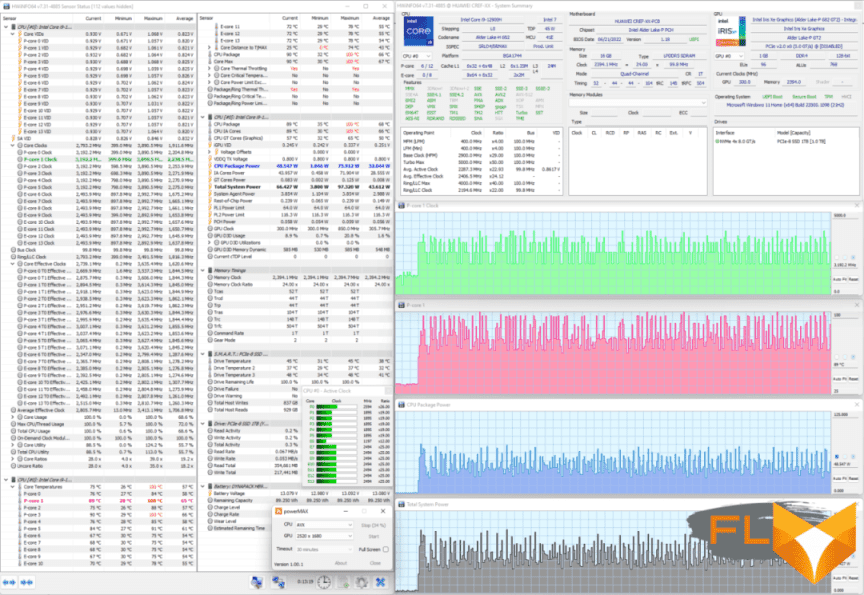
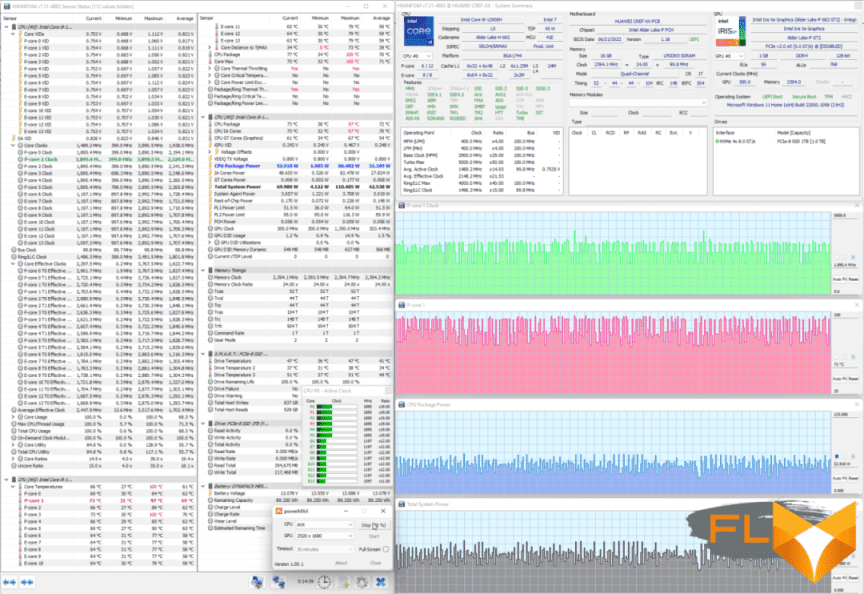
The performance of the laptop in productive and balanced modes is different, but not critical. At first glance, it seems that there are no differences at all, but this is not entirely true. It is clear that throttling is fixed in both cases, but in the productive mode, the frequency of P-cores often stays at 3.2 GHz, although it averages 2.3-2.4 GHz, but in balanced mode it is 0.2-0 .3 GHz below. The power consumption range of the processor is approximately the same: from 30 to 80 watts. The CPU temperature after stabilization is 89 °C in Performance mode and 73 °C in Balance mode.
Now let’s see how the laptop works on battery power, when only Balance mode is available.
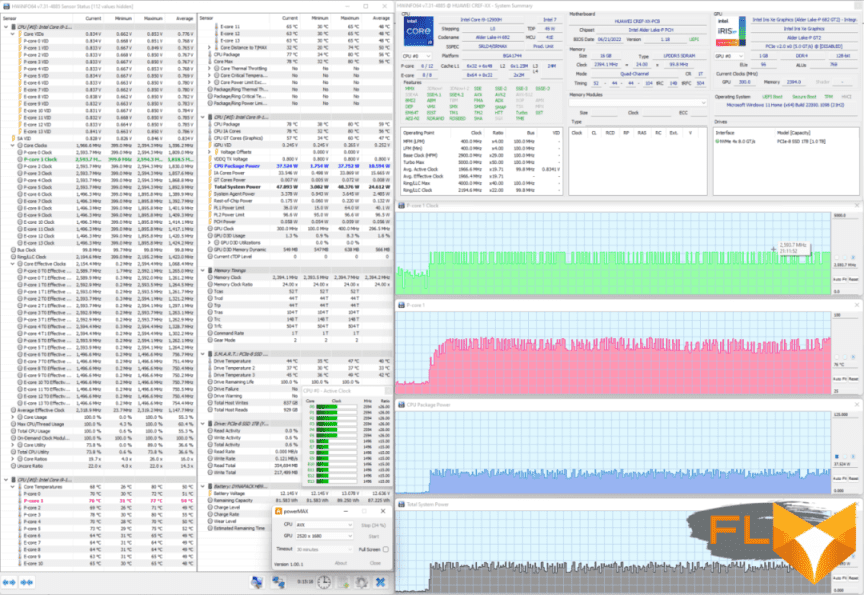
It can be immediately noted that the monitoring graphs are more uniform, the frequency / temperature / power consumption fluctuations are not as strong as when powered from the mains. P-core frequencies stabilize at 1.8-1.9 GHz with power consumption from 25 to 48 watts and a temperature of 76 °C. The noise level in this case is noticeably lower, but even when working from the mains, the laptop is noisy only in stress tests, and in normal work, even with resource-intensive applications, acoustic comfort is maintained.
Noise and heat
We measure the noise level in a special soundproof and semi-dampened chamber. At the same time, the sound level meter microphone is located relative to the laptop in such a way as to imitate the typical position of the user’s head: the screen is tilted back by 45 degrees (or to the maximum, if the screen does not recline by 45 degrees), the microphone axis coincides with the normal emanating from the center of the screen, the front end of the microphone is located at a distance of 50 cm from the plane of the screen, the microphone is directed at the screen. The load is created using the powerMax program, the screen brightness is set to maximum, the room temperature is maintained at 24 degrees, but the laptop is not specially blown, so in the immediate vicinity the air temperature may be higher. To estimate the real consumption, we also give (for some modes) the consumption from the network. The battery is pre-charged to 100%. In the settings of the proprietary utility, the Performance or Balanced profile is selected. The supplied power supply is used:
| Load Scenario | Noise level, dBA | Subjective evaluation | Power consumption, W | Balance | Inactive | background(16,0) | conditionally silent | 17 | Max CPU load | 29,8 | quiet | 68 (maximum 119) | Maximum GPU load | 25,0 | very quiet | 52 (max 79) | Maximum CPU and GPU load | 29,8 | quiet | 71 (maximum 119) | Performance | Maximum CPU and GPU load | 42,2 | very noisy | 94 (maximum 119) | ||||||
|---|---|---|---|---|---|---|---|---|---|---|---|---|---|---|---|---|---|---|---|---|---|---|---|---|---|---|---|---|---|---|---|
If the laptop is not loaded at all, then its cooling system in the case of the Balance profile can work in passive mode. In this profile, even under heavy load, the noise from the cooling system is very moderate. Enabling the Performance profile increases both the performance of the same name and the noise level. In any case, the nature of the noise is even and does not cause irritation. The spectrogram obtained for the maximum fan speed is quite smooth, and there are no pronounced peaks in the frequency range where sounds can cause particular irritation:

For a subjective assessment of the noise level, the following scale is applicable:
| Noise level, dBA | Subjective evaluation | Less than 20 | conditionally silent | 20-25 | very quiet | 25-30 | quiet | 30—35 | clearly audible | 35-40 | noisy | 40—45 | very noisy | 45—50 | loud | Above 50 | very loud |
|---|
Below 20 dBA, the computer is conditionally silent; from 20 to 25 dBA, a laptop can be called very quiet; 35 dBA noise is clearly audible, 35 to 40 dBA noise exceeds the comfortable level for long-term work, 40 to 45 dBA the laptop is very noisy and needs to be masked by background music, for example, 45 to 50 dBA noise level is very uncomfortable, and 50 dBA and above, the noise is so loud that headphones must be used. The scale, of course, is very conditional and does not take into account the individual characteristics of the user and the nature of the sound.
Below are thermal images obtained after long-term operation of the laptop under maximum load on the CPU and GPU (Performance mode):
Under maximum load, working with the keyboard is comfortable, since the places under the wrists practically do not heat up. A laptop on your lap isn’t particularly fun, but your knees block the intake vents, which adds to the noise and can cause overheating. The power supply gets very hot, so you need to make sure that it is not covered with anything during long-term operation with high performance.
Performance
We tested the performance of the CPU, RAM and storage of the Huawei MateBook 16s ultrabook in real applications in accordance with the methodology and application set of our test suite. For comparison, the table includes a reference system based on a 6-core Coge i5-9600K processor, as well as the results of a Huawei MateBook 16 with a Ryzen 7 5800H processor and a recently tested Huawei MateBook X Pro 2022 with a Coge i7-1260P processor. All laptops were tested in maximum performance mode when powered by mains power. The results are shown in the table.
| Test | Reference result (Core i5-9600K) | Huawei MateBook 16s CREF-X (Core i9-12900H) | Huawei MateBook X Pro 2022 MRGF-X (Core i7-1260P) | Huawei MateBook 16 Crem-WFD9 (Ryzen 7 5800H) | Video conversion points | 100.0 | 139.1 | 100.9 | 135.7 | MediaCoder x64 0.8.57, c | 132,03 | 88,42 | 129,12 | 92,65 | HandBrake 1.2.2, c | 157,39 | 108,73 | 166,97 | 117,67 | VidCoder 4.36, c | 385,89 | 309,85 | 362,27 | 294,26 | Rendering points | 100.0 | 174.6 | 123.5 | 154.9 | POV-Ray 3.7, c | 98,91 | 51,45 | 81,45 | 65,41 | Cinebench R20, c | 122,16 | 62,40 | 99.44 | 77,65 | Blender 2.79, c | 152.42 | 92,64 | 134,85 | 107,44 | Adobe Photoshop CC 2019 (3D rendering), c | 150,29 | 100,23 | 109,09 | 88,10 | Video content creation, points | 100.0 | 151.2 | 126.3 | 118.5 | Adobe Premiere Pro CC 2019 v13.01.13, c | 298,90 | — | — | 253,20 | Magix Vegas Pro 16.0, c | 363,50 | 202,00 | 252.00 | 402,00 | Magix Movie Edit Pro 2019 Premium v.18.03.261, c | 413,34 | — | — | 312,79 | Adobe After Effects CC 2019 v 16.0.1, с | 468,67 | 293,00 | 347,00 | 314,00 | Photodex ProShow Producer 9.0.3782, c | 191,12 | 159,00 | 185,00 | 172,00 | Digital photo processing, points | 100.0 | 161,2 | 138.6 | 96.8 | Adobe Photoshop CC 2019, s | 864,47 | 640,96 | 621,53 | 747,68 | Adobe Photoshop Lightroom Classic CC 2019 v16.0.1, c | 138,51 | 59,86 | 78,23 | 155,46 | Phase One Capture One Pro 12.0, c | 254,18 | 189,46 | 234,92 | 289,01 | Text recognition score | 100.0 | 175.1 | 121.5 | 178.7 | Abbyy FineReader 14 Enterprise, c | 491,96 | 280,94 | 404,83 | 275,35 | Archiving, points | 100.0 | 180.5 | 143.5 | 120.7 | WinRAR 5.71 (64-bit), c | 472,34 | 263.95 | 320,58 | 391.75 | 7-Zip 19, c | 389,33 | 213,96 | 278,57 | 322,01 | Scientific calculations, points | 100.0 | 149.4 | 106.5 | 130.0 | LAMMPS 64-bit, c | 151,52 | 98,82 | 123,47 | 102,29 | NAMD 2.11, c | 167,42 | 109,60 | 169,69 | 144,08 | Mathworks Matlab R2018b, c | 71,11 | 44,46 | 68,08 | 53,65 | Dassault SolidWorks Premium Edition 2018 SP05 with Flow Simulation 2018, c | 130,00 | 102,00 | 128,00 | 104,00 | Integral result without accumulator, points | 100,0 | 160,9 | 122,1 | 131,4 | WinRAR 5.71 (Store), c | 78,00 | 25,14 | 24.85 | 24,22 | Data copying speed, c | 42,62 | 10,30 | 11.05 | 10,09 | Integral result of the accumulator, points | 100,0 | 358,2 | 347.9 | 354.7 | Integral performance result, points | 100,0 | 204,6 | 167,2 | 177.0 |
|---|
Objectively, it was impossible to say that the performance of the previous Huawei MateBook 16 was lacking somewhere (we don’t take games into account). However, the MateBook 16s with the Coge i9-12900H mobile processor outperforms it in the integral result without taking into account the drive by 22.5%, while the Huawei MateBook X Pro 2022 with the Coge i7-1260P processor immediately lags behind by 31 ,eight%. The advantage was recorded in almost all groups of tests, with the exception of text recognition and video transcoding, and it looks especially impressive in graphic editors and archivers.
In 3D benchmarks, the Iris Xe graphics core is noticeably ahead of the graphics integrated in the Ryzen 7 5800H (by 70% or more in some tests).

Battery life
The kit of the most “pumped” Huawei MateBook 16s includes a 135-watt power adapter (20.0 V, 6.75 A), but the model with the Coge i7-12700H processor is equipped with a 90-watt power adapter.
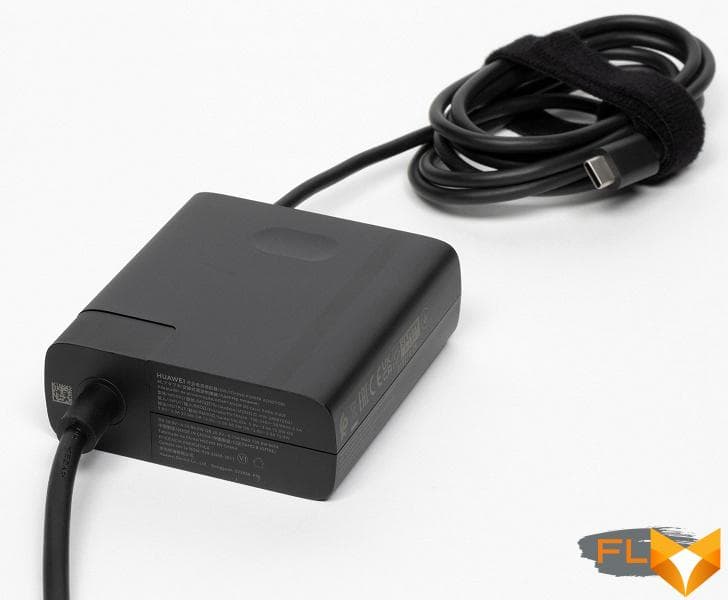
It is stated that such a power adapter is able to replenish the battery charge from 0 to 50% in 30 minutes. You can charge the laptop through any of the two USB Type-C ports; during the charging process, a white LED lights up on the end of the case.

Both USB ports can also supply power, which is implemented by a pair of controllers Realtek 5452E с технологией Power Delivery.
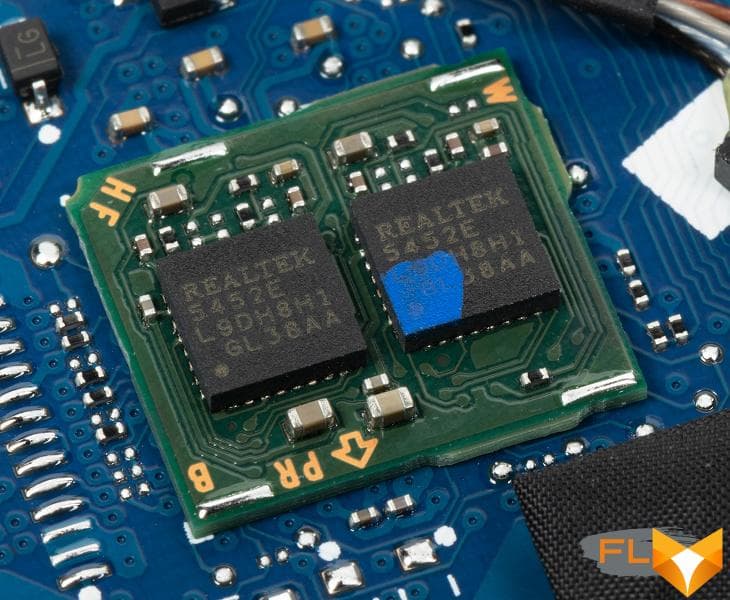
Notebook battery capacity has not changed compared to the previous model and is 84 Wh (7330 mAh).
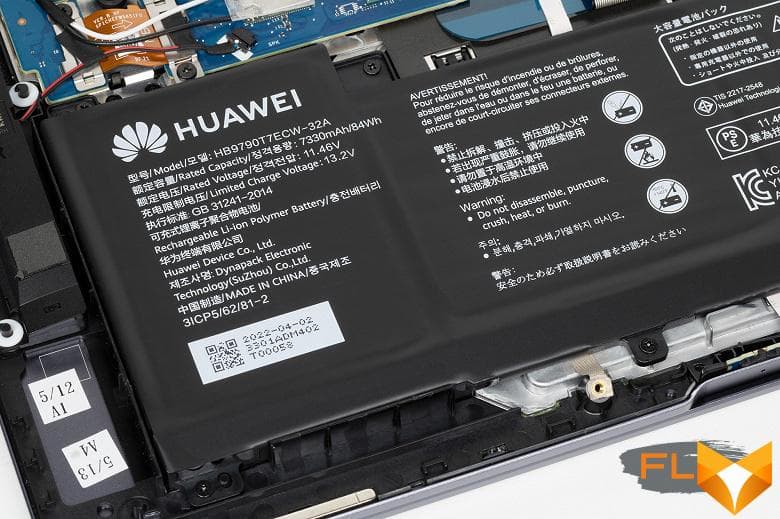
However, according to diagnostic utilities, when fully charged, the battery capacity can reach 89.3 Wh, which is what a regular MateBook 16 has was not fixed.

We performed four full charge cycles of the Huawei MateBook 16s laptop battery from 3% to 99%, and the average charge time was 2 hours and 11 minutes. At the same time, the battery really gains the first 50% in no more than 35 minutes.
Testing the autonomy of the laptop was carried out according to our methodology, as well as additionally in the 3DMark benchmark using the Fire Strike looped test. The screen brightness was set to 100 cd/m² (in this case, about 33% in this case), so laptops with relatively dim screens don’t benefit.
| Load Scenario | Opening hours | Working with text (keyboard backlight at maximum) | 11 h 55 min | View video | 8 hours 41 minutes | 3DMark Fire Strike (loop) | 1 hour 58 minutes |
|---|
Again, when compared with the previous model, then, by and large, the Huawei MateBook 16s did not increase autonomy. But the results were not lower either – the level is about the same. On the one hand, there is no progress in this component of the laptop, and this is not very cool. On the other hand, let’s not forget about the increased performance, so the not reduced battery life of the laptop is a plus for the MateBook 16s.
Conclusions
We decided to list the advantages that the model with a small letter “s” has over the “regular” MateBook 16 (CREM-WFD9):
- Better Alder Lake CPU coupled with LPDDR5-4800 RAM (more than 22% performance boost);
- the webcam is now 1080p and moved from the button to the frame above the screen, and at the program level, the ability to replace the background, auto-center and change the direction of view has been added;
- Faster Wi-Fi 6E with up to 2.4Gbps;
- One USB Type-C port now supports Thunderbolt 4 (up to 40Gbps);
- a powerful power adapter is included (up to 135 W for the older model and up to 90 W for the other two);
- Support for the “Superdevice” universal integration function
The laptops do not differ at all in design, keyboard, touchpad, sound, and even the 2.5K screen showed almost the same characteristics. The cost also remained at the same level: 1800-1950 dollars. In the bottom line, Huawei has turned out to be another “workhorse” (this time a little more sharpened for remote work with its endless video calls) with an even better combination of performance and cost, which will definitely find its customers.
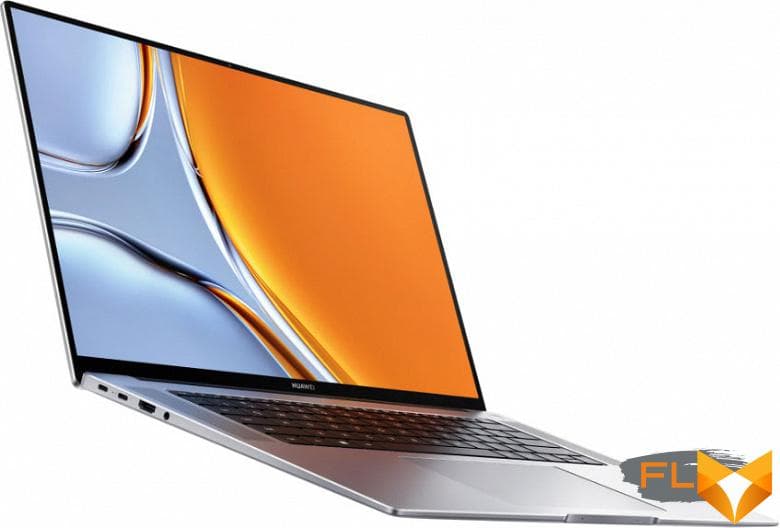
FAQ Huawei Matebook 16s
How does the Intel Core i9 processor enhance the performance of the new Huawei Matebook 16s?
The inclusion of the Intel Core i9 processor, specifically the 12th gen Intel Core i9-12900H, in the new Huawei Matebook 16s provides exceptional performance levels, particularly in multitasking and demanding applications, making it one of the best big 16-inch laptops for professionals and creatives.
One of the Matebook 16s’ key differentiators is its striking 16-inch display with an optimal aspect ratio, which, combined with a powerful Intel Core i9-13900h processor, positions it as a robust option for those seeking a blend of performance and visual real estate.
Are there any connectivity improvements in the Matebook 16s compared to last year’s Matebook 16?
Yes, the Huawei Matebook 16s has enhanced its connectivity options; it now includes an SD card reader, a USB-C port, and two USB-A ports, providing comprehensive connectivity for various devices and accessories.
How does the Matebook 16s keyboard enhance the user experience for professionals?
The Matebook 16s offers a laptop keyboard designed with both responsiveness and comfort in mind, ideal for long work sessions. The key travel is well-balanced, providing a satisfying typing experience, which is crucial for a work laptop.
What is the significance of Huawei equipping the Matebook 16s with the 12th Gen Intel Core i9-12900h processor?
By integrating the 12th Gen Intel Core i9-12900h, Huawei has equipped the Matebook 16s with one of the most powerful CPUs available, making it incredibly fast for a laptop and well-suited for intensive tasks like video editing or 3D rendering.
How does the Matebook 16s complement the Huawei ecosystem?
The Matebook 16s is designed to work seamlessly with other Huawei devices, especially Huawei phones. Features like multi-screen collaboration are enhanced, allowing for easy file transfer and streamlined continuity across devices within the Huawei ecosystem.
Is the Huawei Matebook 16s suitable for media consumption?
Absolutely, with its 16-inch display, impressive audio capabilities, and high-resolution screen, the Matebook 16s is great for media consumption, providing an immersive viewing experience that’s rare to find on a laptop this big.
What’s unique about the software in the Matebook 16s?
Huawei packs only one vital proprietary application known as the Huawei Command Center, which allows users to customize performance settings, manage system health, and optimize the laptop’s various features for a tailored user experience.
How does the Matebook 16s perform in terms of portability and battery life?
Despite its larger screen, the laptop is still relatively lightweight for its class, and Huawei claims the battery can support several hours of intensive use, making it suitable for those on the go.
Has there been any significant design change in the 2022 Matebook 16s compared to the recent Matebook D 16?
While retaining some design cues from the recent Matebook D 16, the new Matebook 16s introduces refinements for a more premium feel and improved user experience, such as slimmer bezels, a better screen-to-body ratio, and enhanced cooling system.
How does the Matebook 16s compare to other Windows laptops in the same category?
The Matebook 16s stands out among Windows laptops due to its powerful core i7 processor, high-quality 16in display, and robust build quality, making it a great laptop for both professional and personal use.
What are the spec highlights of Huawei’s Matebook 16s that make it an impressive choice for consumers?
The Matebook 16s features a core i7 processor, a vivid 16-inch display, ample storage, and efficient cooling system, combined with a sleek design, making it an attractive option for those looking for a laptop with both power and style.
Why does Laptop Mag rate the Matebook 16s so highly?
Laptop Mag recognizes the Matebook 16s as one of the top options in its category due to its superior performance, excellent display, and long-lasting battery life, which are critical factors for users who need a reliable and high-performing machine.
What is one feature Huawei hasn’t compromised on with the Matebook 16s?
Huawei hasn’t compromised on build quality with the Matebook 16s. The laptop comes with a sturdy, premium body that can withstand regular use, making it a solid laptop choice for users who value durability.
How does the Matebook 16s enhance the user experience compared to other Matebook laptops?
The Matebook 16s offers an immersive visual experience with its larger screen, improved audio quality, and responsive keyboard, features that are essential for those looking for a laptop that’s efficient and comfortable to use.
Why would consumers opt to get the Matebook 16s over other laptops?
Consumers might prefer the Matebook 16s due to its combination of powerful performance, elegant design, and competitive pricing, all packed into a portable 16in laptop that’s great for both work and entertainment.
What has Huawei done to ensure the Matebook 16s is a great laptop for multimedia tasks?
Huawei has equipped the Matebook 16s with high-quality speakers, a vibrant display, and powerful processing capabilities, ensuring an unmatched multimedia experience whether you’re streaming video, editing photos, or gaming.
How does the battery life of the Matebook 16s hold up since the laptop features such high-end specs?
Despite its powerful specs, Huawei advertises an impressive battery life for the Matebook 16s, thanks to its energy-efficient components and software optimizations, allowing users to work or play for several hours on a single charge.
In what ways is the Matebook 16s a solid laptop for professional use?
The Matebook 16s ships with Windows 11, offers robust security features, and has ample connectivity options, making it a reliable and versatile choice for professionals needing to stay productive on the go.
What makes the Matebook 16s stand out in the visual department compared to its predecessors?
The Matebook 16s features slimmer bezels and a higher screen-to-body ratio than its predecessors, like the Matebook X, providing a more immersive visual experience for users engaged in everything from content creation to media consumption.
How does the Matebook 16s compare to the Matebook D16 in terms of performance and features?
The Matebook 16s isn’t just a successor to the Matebook D16; it’s an upgrade. While both are high-performance machines, the Matebook 16s comes with the latest generation of processors and graphics, ensuring faster and more efficient performance. The laptop also features a more robust cooling system and a higher resolution display, making it an impressive choice for both professionals and creatives.
What aspects of the Matebook 16s were highlighted in the review unit received by tech analysts?
In the review unit provided to analysts, the Matebook 16s was praised for its sleek design, high-quality display, and exceptional keyboard and touchpad quality. The review emphasized that the Matebook 16s is one of the best in its class, thanks to its combination of functionality, performance, and aesthetics.
Can you elaborate on the innovations Huawei has delivered with the new Matebook 16s?
Huawei has delivered a range of innovations with the Matebook 16s, notably its full-view display with minimized bezels and a high screen-to-body ratio, a powerful speaker system, and a significantly improved thermal design for enhanced performance. Huawei also incorporated a larger battery to ensure extended usage without compromising on the laptop’s slim profile.
What are the distinctive features that Huawei has done differently with the Matebook 16s compared to the features you’d find on the Matebook X?
Compared to the features you’d find on the Matebook X, the Matebook 16s boasts a larger display with higher resolution, a more powerful processor, and an enhanced cooling system, ensuring it can handle more intensive tasks. Additionally, Huawei has done an excellent job of maintaining a slim and lightweight design despite these enhancements.
What is the “One Hop” feature Huawei calls attention to in their Matebook 16s promotional material?
“One Hop” is a feature Huawei would highlight for its convenience and innovation. It allows for seamless file transfer between the Matebook 16s and Huawei smartphones. With a simple tap, users can transfer images, videos, and documents between devices without the need for cables or complex settings, showcasing the Matebook 16s as an impressive addition to the Huawei ecosystem.
